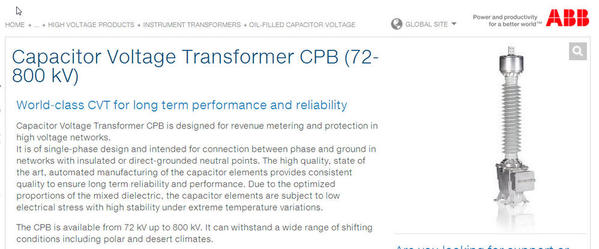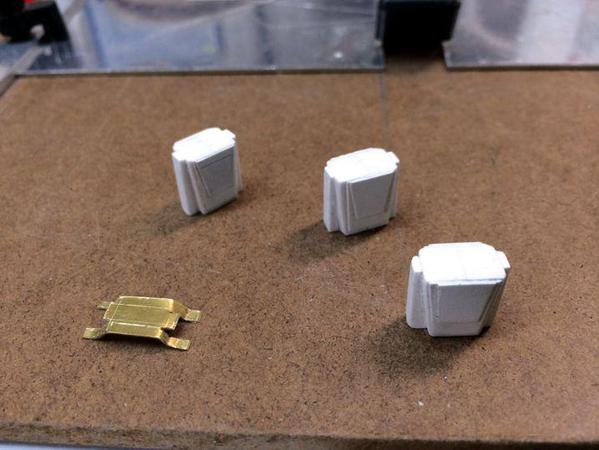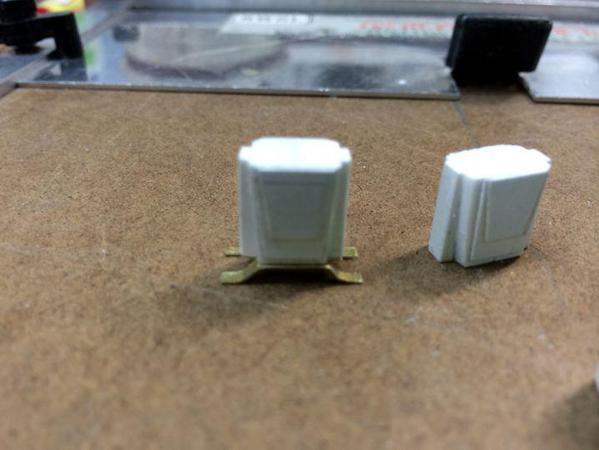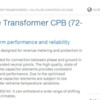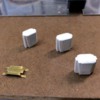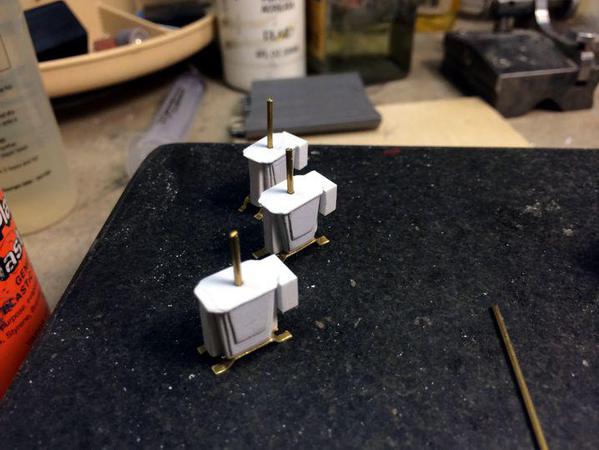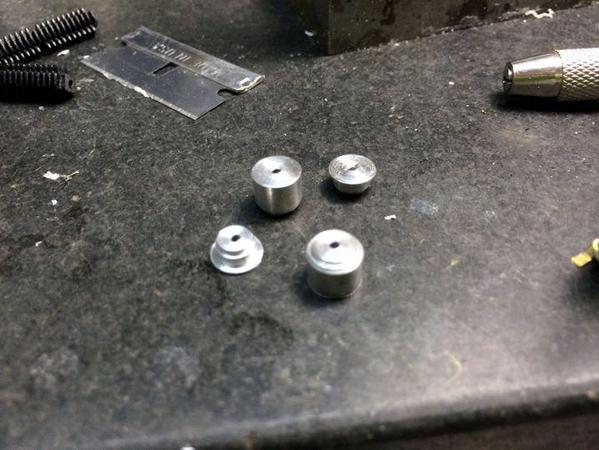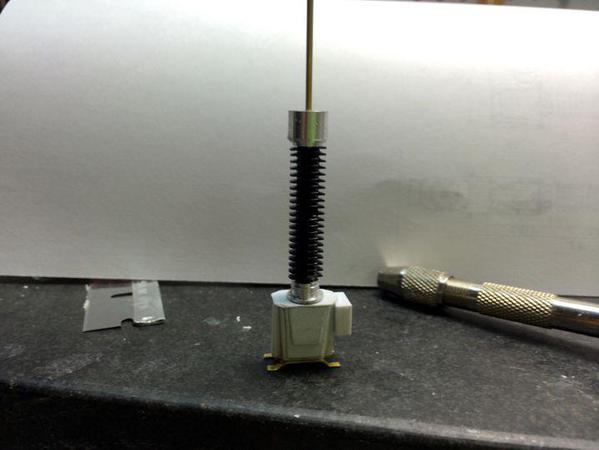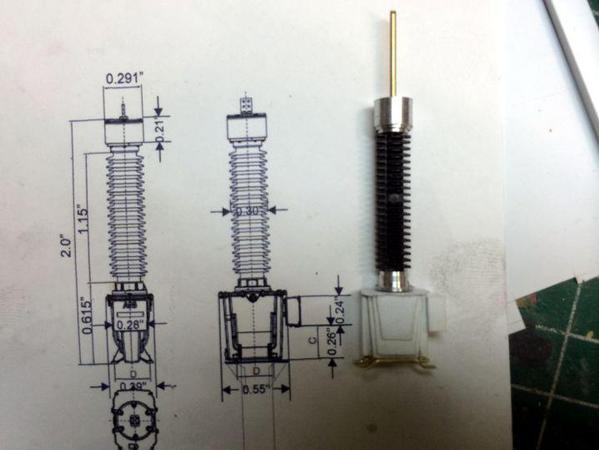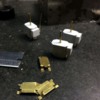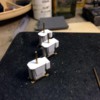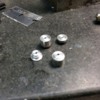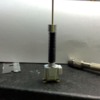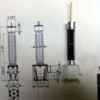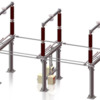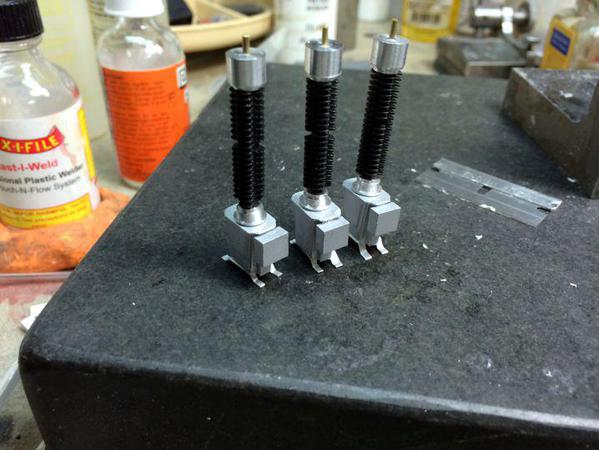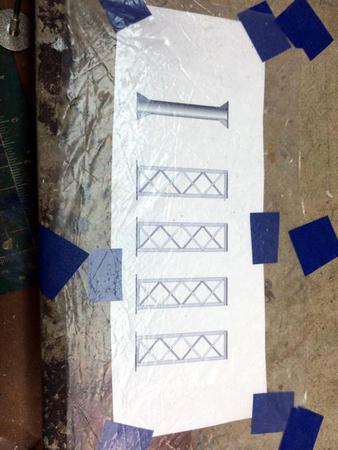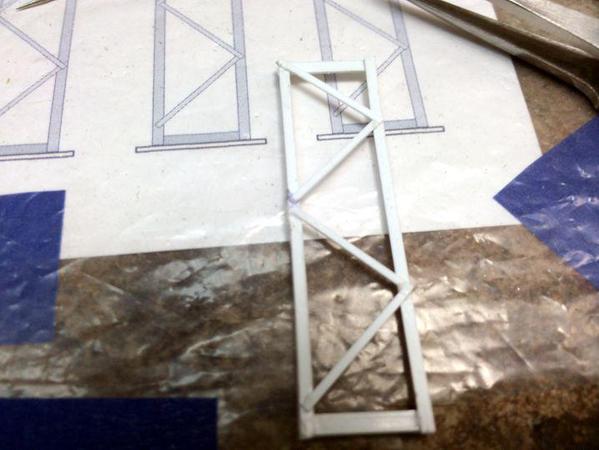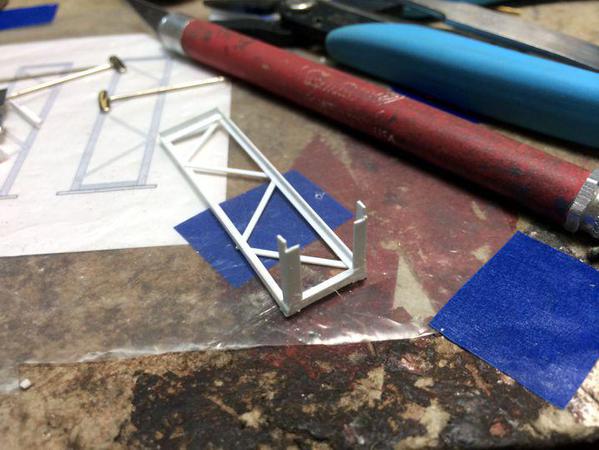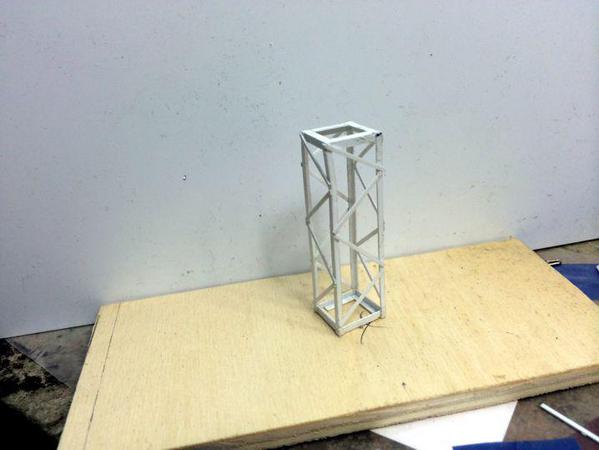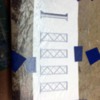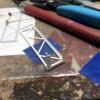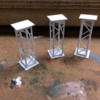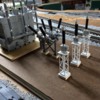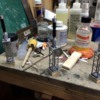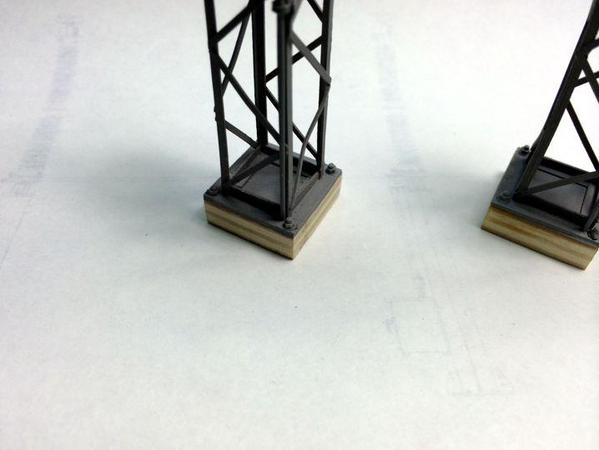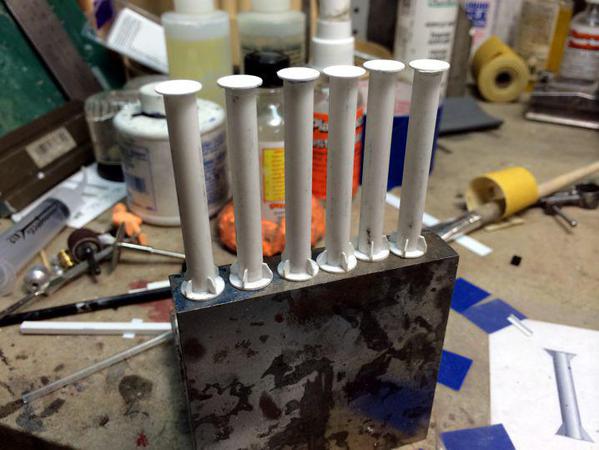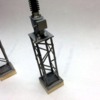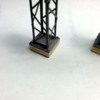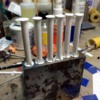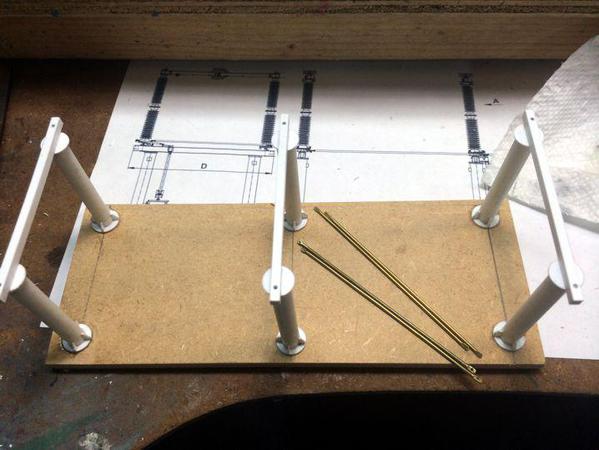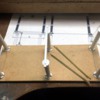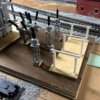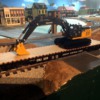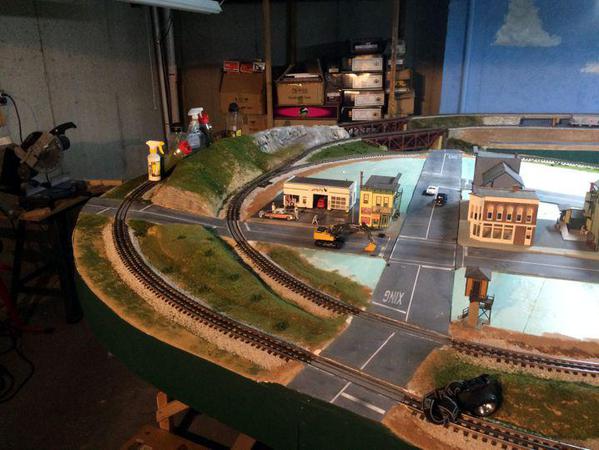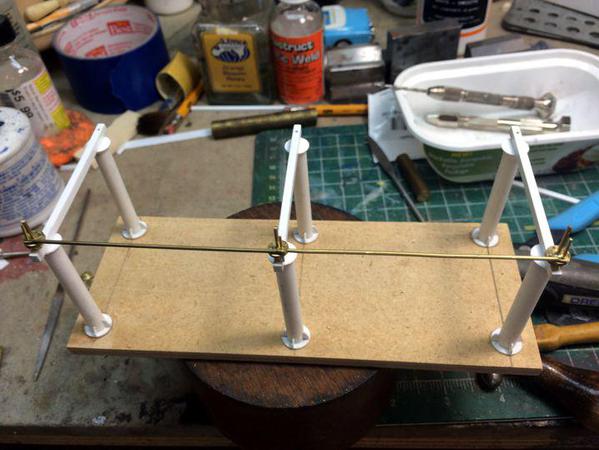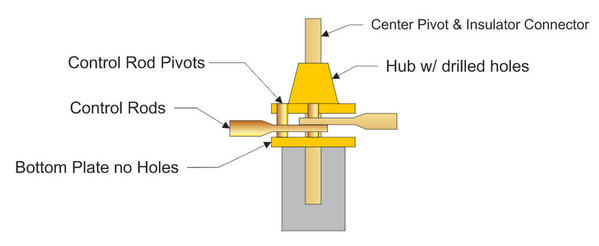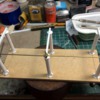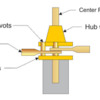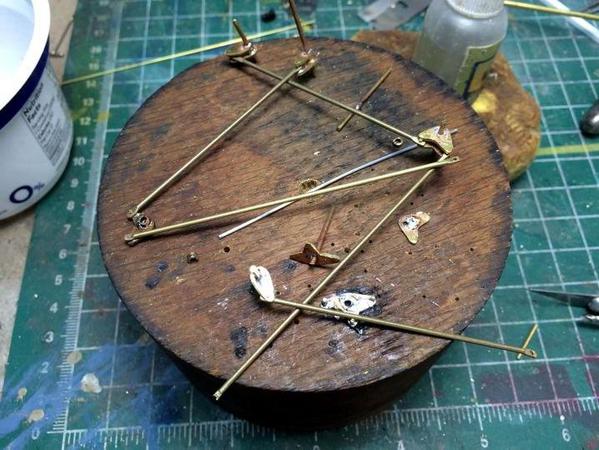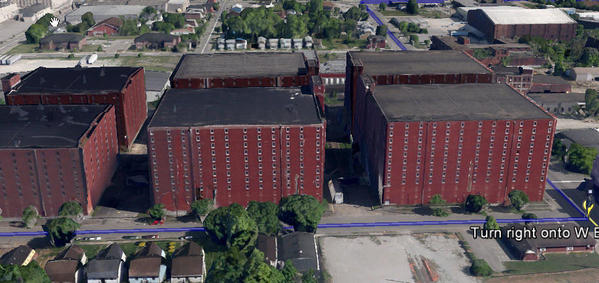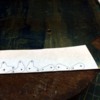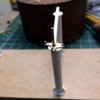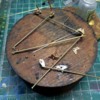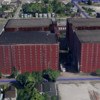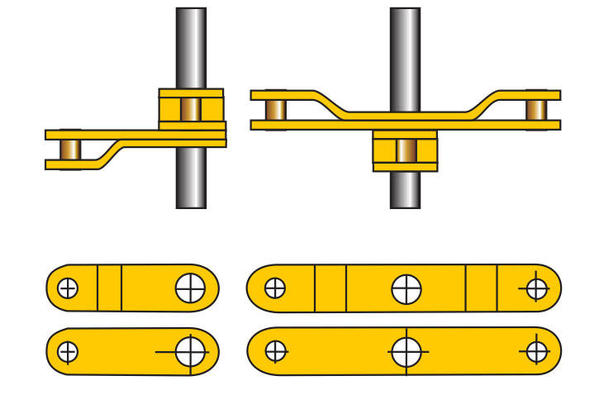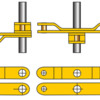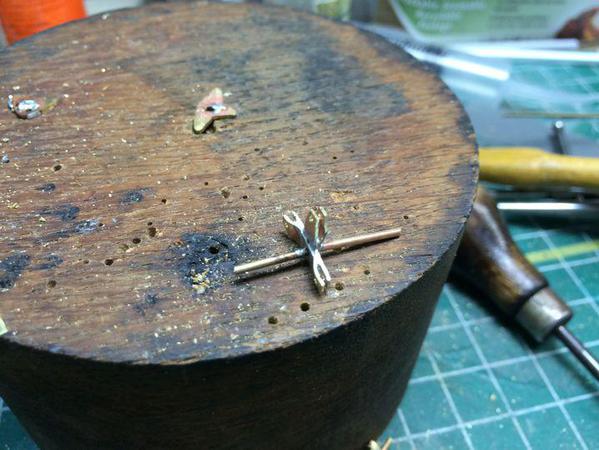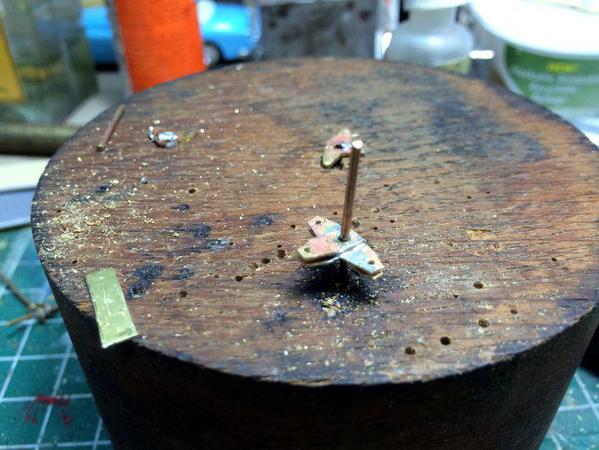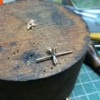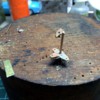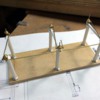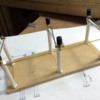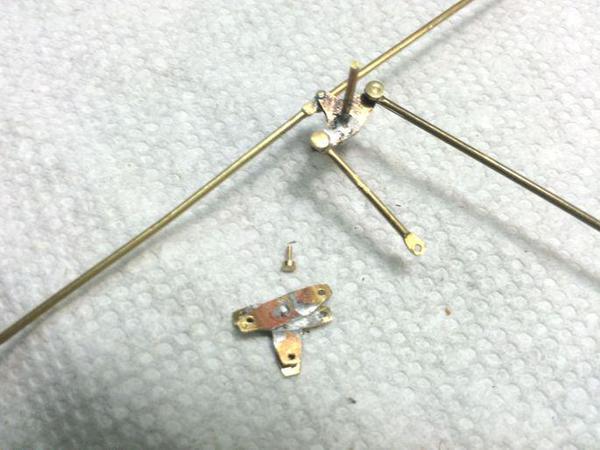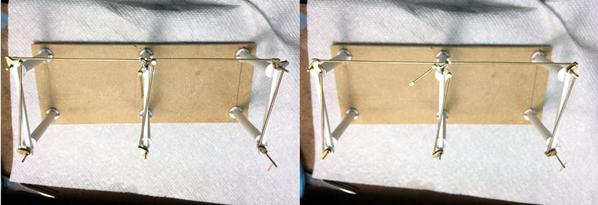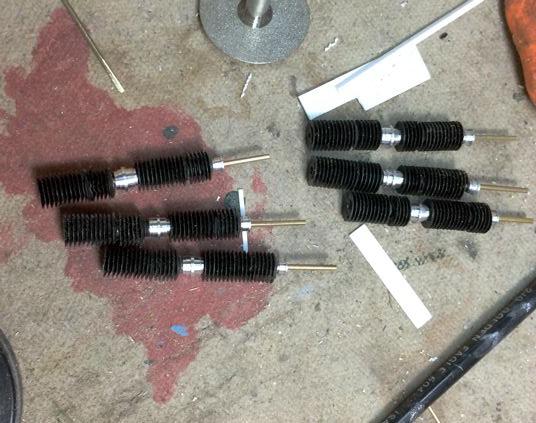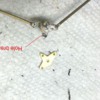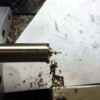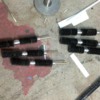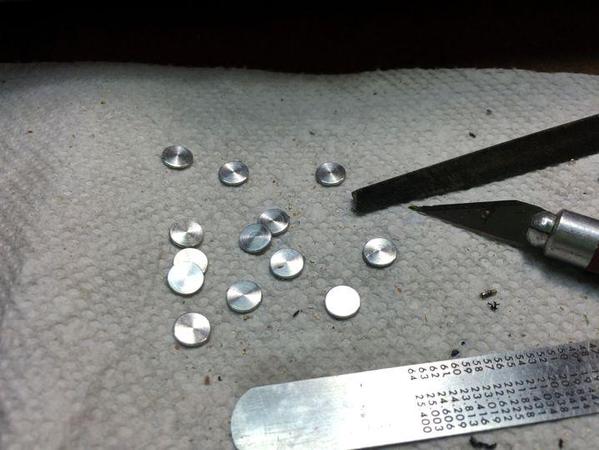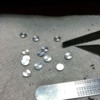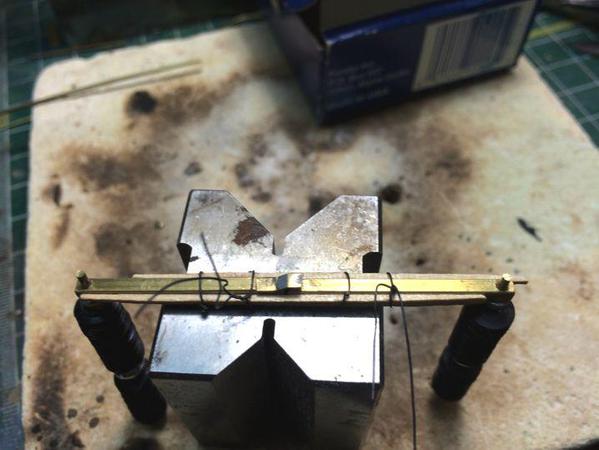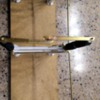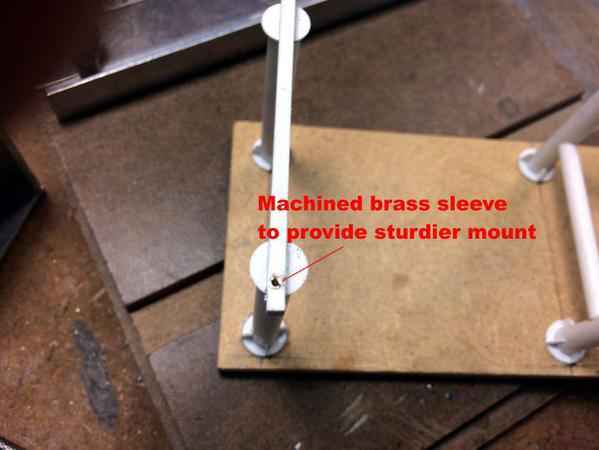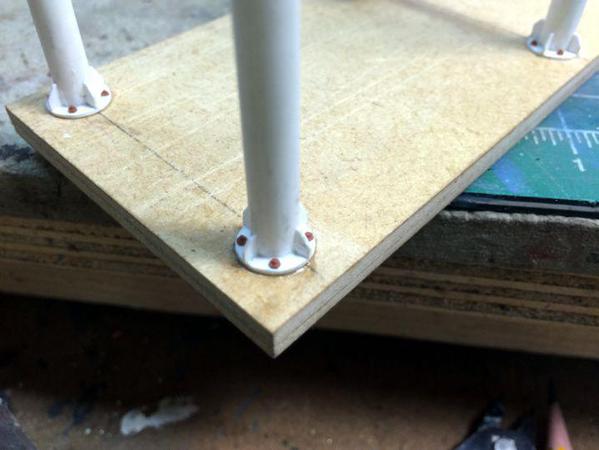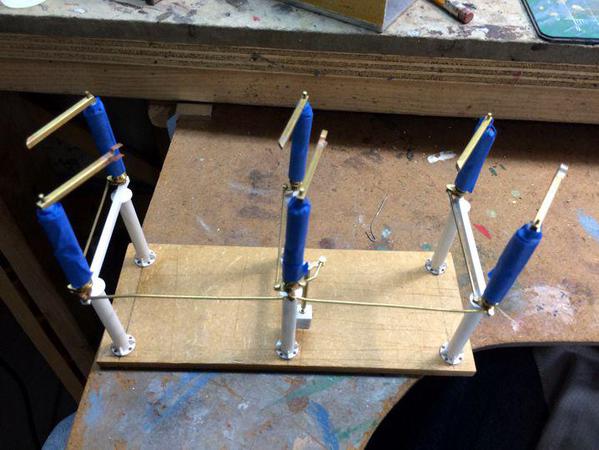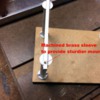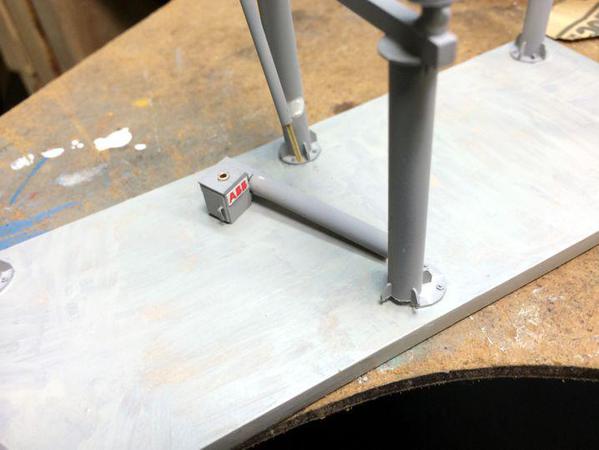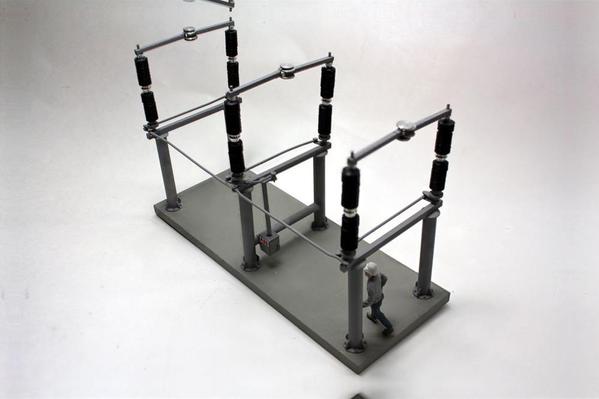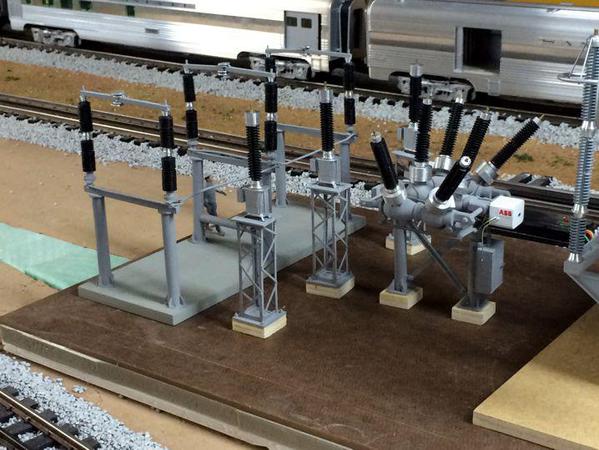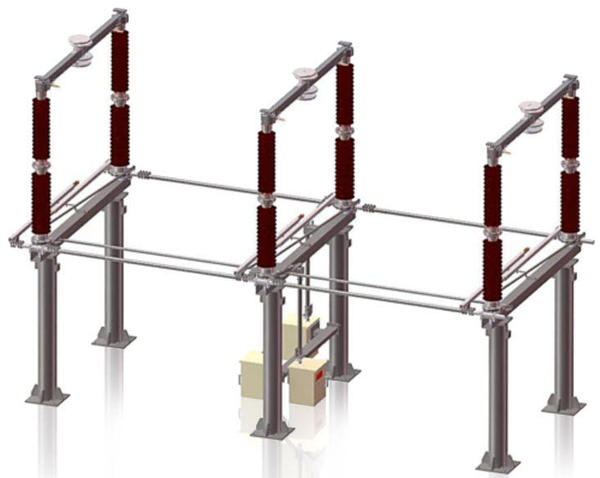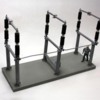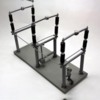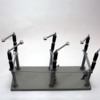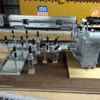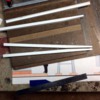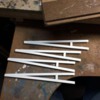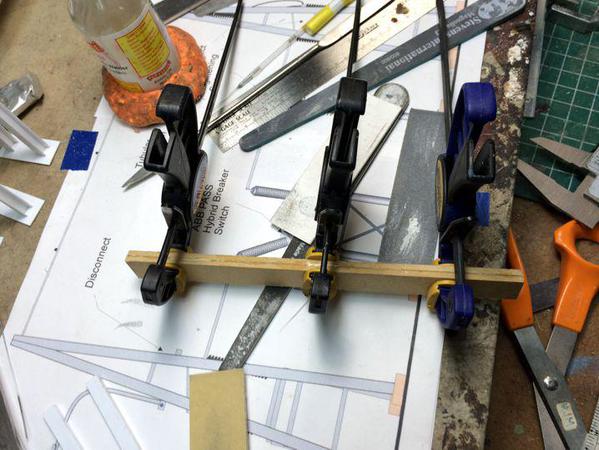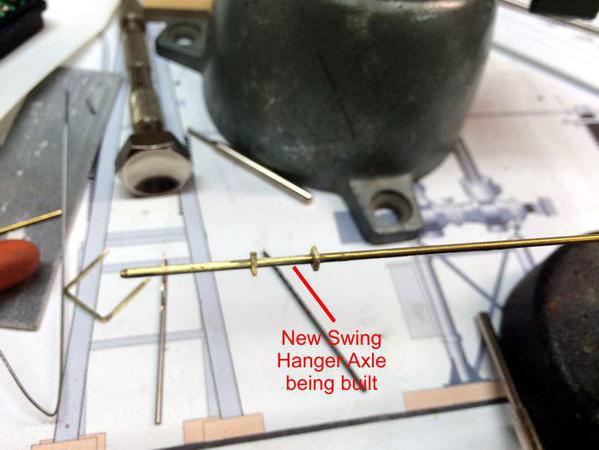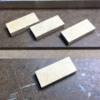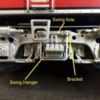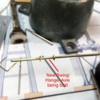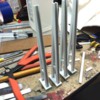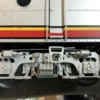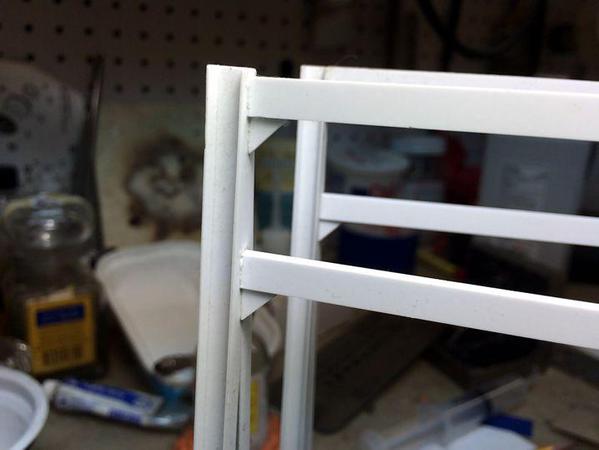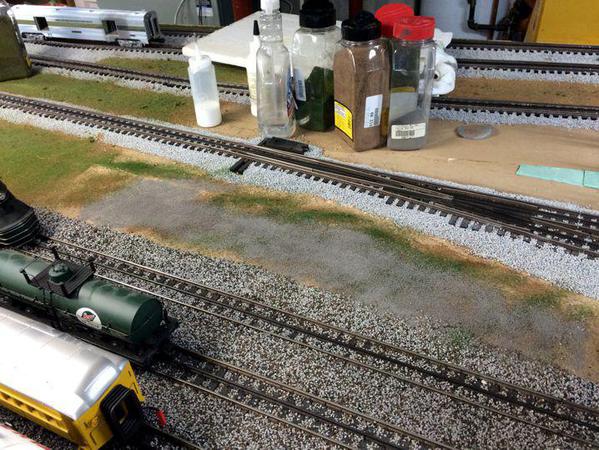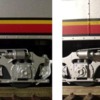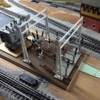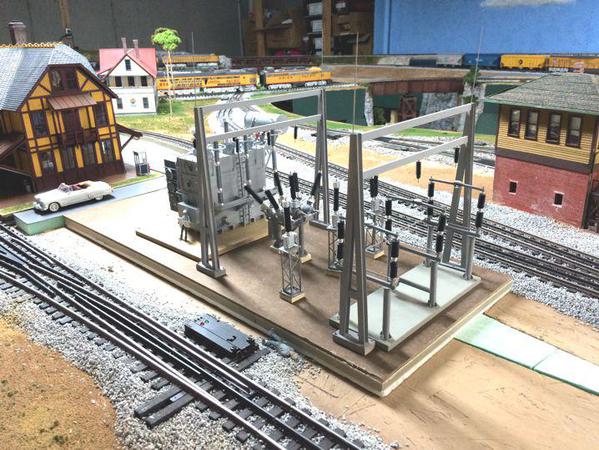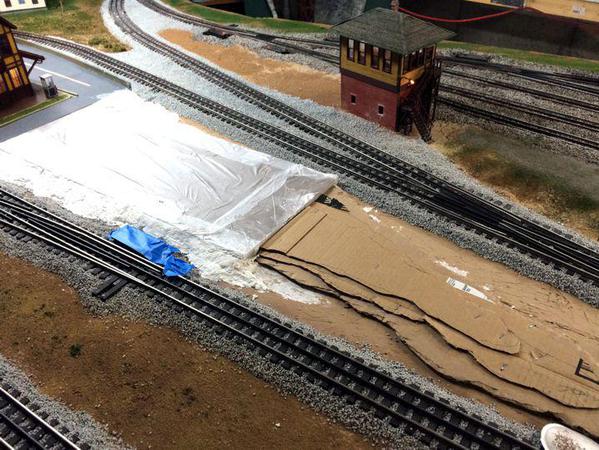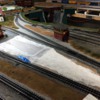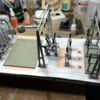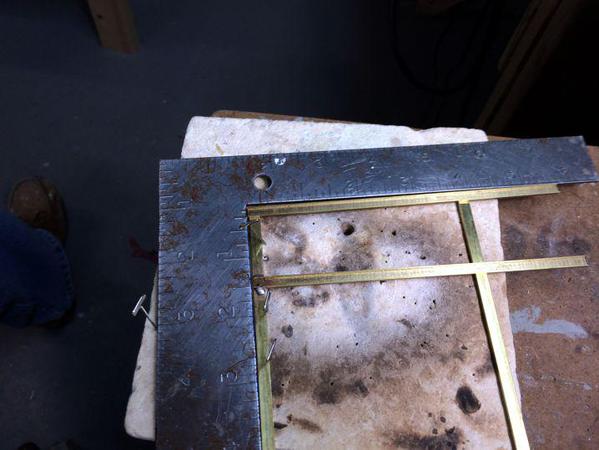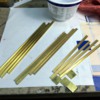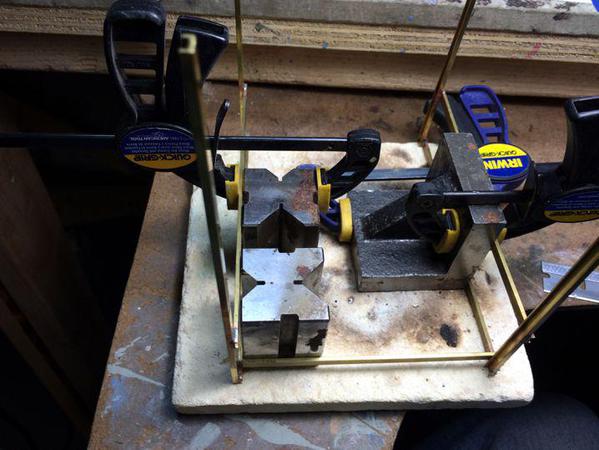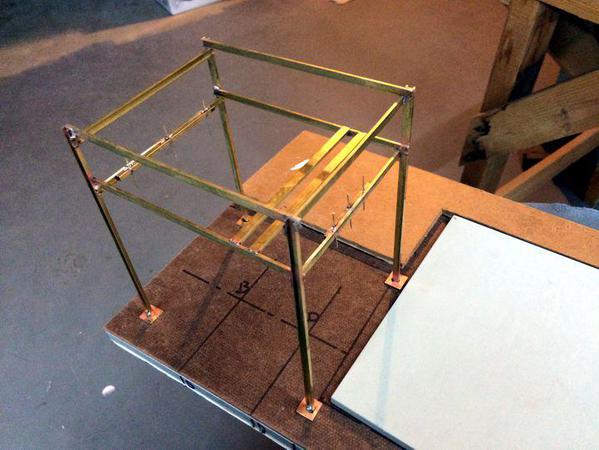You are going all out. However, when I know something is missing, it stands out like a sore thumb to me, but no one else notices or even knows. You seem like me in that regard. We called them Capacitive Coupled Potential Devices CCPD. Ours were probably made by GE, if memory serves. Looks like you are moving right along.
Andre, I am assuming that "abyssmal" and "didactic" are good things. Thanks to all!
Trainman2001, just good thinks.
there is no room for nothing else.
Andre.
Mark, here's the descriptive page for the CVT. There's probably different names depending on the manufacturer.
Only had about 45 minutes in the shop today, but did get some progress. I finished shaping the three housings and started making the base plate. I decided to make this part out of brass since I wanted to make the legs integral with the base for strength.
I was using the belt sander to rough out the housing and knocked a couple of the glued pieces off, so I cut the excess off with the razor saw that was more gentle.
The housing sits on the base nicely. These will be CA'd together. The feet will be glued to stand with epoxy.
I bought auto fasteners in both styles and will decide which I'm going to use as I go on. The long ones that I used for the transformer and breaker would work for this item also and I wouldn't have to piece two of them together.
Attachments
You just keep outdoing yourself. These housing are so true to life. Really spectacular.
Practice makes perfect... I had another rare Saturday work session. The weather wasn't so nice and my wife was happy watching football. Go figure... I like to be in the basement and she watches sports.
It was a very productive day with the completion of the housings including the top plate and the junction box, the remaining base plates, shaping the insulators and drilling, and turning all the top and bottom fittings.
The top plate overlaps the sides just a little bit. I located the center and drilled them with the 0.047" drill for the brass support rod. I then cut the junction boxes off a piece of 1/8" X 1/4" styrene stock. I sanded the ends true and glued them in place. I also CA'd the brass rod into the holes in anticipation of adding the insulators.
I then glued the bases to the housings using 45 minute epoxy.
While this was curing I went back to the lathe and prepared the insulators by drilling the .041" hole from both ends. The insulators were just a tad loose in my collet chuck so I wrapped one layer of paper around them and it clamped nicely. The Taig's collets don't have much range. They're really only good for nominal-sized stock, but the paper worked well.
I then machined both the top and bottom insulator fittings. As I noted on my opening, practice does make perfect, and I was able to knock all six pieces out in about a 1/2 hour. Instead of changing tool bits between linear cutting and cutoff, I simply used the cutoff tool for the whole job. I also just dialed in the correct amount and cut the entire depth coming in from the side. The cutoff tool has some side relief so it will cut metal when moving sideways. It's not efficient, but with such tiny cuts it was the fastest way to do it.
I couldn't resist trying all the parts together even though the epoxy wasn't really cured yet.
Looks like a CVT to me...
Here's the CVT laid on top of the prototype drawing.
Next session I'll paint the base and glue it all together, then start working on the stand. As I noted last post, I'm toying with the idea to build a lattice-type structure, just to add more interest. If it proves to difficult, plan B will be to use a cylindrical post.
Update: With the CVT pretty well under control, I'm working on the last component on the High Voltage side; the main front-end disconnect. I've selected the ABB 145 Kv Center-break Disconnect. It's reasonably complicated, but not ridiculous. It will require some more soldering, metal work, and lathe work, but nothing too challenging. This design will fit on the site plan that I have.
Side View
End View showing 3 phases
Layout: It works this way: The two tower insulators rotate away from each other separating the conducting beam in the middle. There is a male and female switch contact in the middle that slide apart far enough to extinguish the arc. This drawing shows control cabinets for each phase so they can be disconnected separately.
I'll start building this when the CVT is done.
Attachments
Yes different companies could use different names. The meanings are the same. they are coming along nicely!
Thanks Mark!
They're coming along so nicely that they're almost done. Went to the hobby shop and got .010" X 040" strip, .060" angle and a pack of .030" sheet stock. I then came home and got to work. I first rolled some tape to make it double-side and stuck the CVT bases to it so I could airbrush it flat aluminum. I then assembled the CVTs with CA. They're now complete.
With that out of the way I got to work making the lattice stands.
Before getting started I needed to make sure that the height would be correct. I wanted the CVTs to be the same height as the highest bushing on the Hybrid Breaker. My original drawing was based on the ABB Hybrid drawing, but my as-built was an unknown. I got my hyrbrid and set the surface gauge to this height. I then took my drawing, folded it into a square tower, set it on some 030 stock as a base plate and onto the plywood I'm using for the concrete foundation. It was too short by almost a 1/4". So it was back to CorelDraw to re-draw the lattice towers to conform to the new size.
I then taped the drawing to the Homasote work table surface (like I did when I built the bridges) and covered it with a sheet of polyethylene so nothing sticks.
At first I used pins to hold stuff in place, but quickly found that the .060" angle was to flexible and would bend and warp with very little pressure. I then added so angle blocks to form a square corner and only use on pin to keep on piece of angle tight into the corner. For the top and bottom angles, I used .080" since it offered a little more bulk. For the first pieces put in, I just used a square cut on the angle to nestle into the corner.
I then installed four diagonal members into the basic frame. At first I was using a small artist's brush to apply the solvent cement, but got my Touch-n-Flow working even though I broke off the back half of the glass tube. With these braces in place, the first frame had a little stability.
I built two sides, representing the front and back. To connect them I again needed to add the .080" angle at four corners. But now I needed to do a little sculpting to get them to fit properly.
If I wanted to avoid making these coping cuts I could have mitered the corners of all the base angles, but I did it this way.
All four corners got angles and then I carefully glued the other frame on one corner at a time.
With front and back in place, I was able to add the remaining diagonal braces to complete the frame.
I checked this frame against the Hybrid Breaker before starting the other frames just to make sure that it was correct.
It was correct so I went into production and knocked out the other two. As usual, I developed easier techniques moving ahead, and the last two took less time than building the first one. I glued top and bottom plates on to ensure that these units would be strong. Before gluing on the plates I carefully touched up the two ends on the Precision sander to give them a true gluing surface.
And just for fun—and just to remind everyone that this is ACTUALLY a model railroad project—I put all the finished parts onto the substation base on the layout. Tomorrow, I will airbrush the stands the sky gray I'm using for all the apparatus, epoxy the CVTs and the "concrete" bases to the stands. And then it's onto the center-disconnect switch.
Attachments
WOW!! That last photo brings back so many memories! I could rattle off the names of scads of stations that had that same look!!
I know its have been more than hinted at, but I hope you continue this same level of detail and make the entire substation. The good think about subs is that while the components - transformer, breakers, etc., were standard products, they could be arranged any way to fit the footprint of the site, within clearances that is. This gives you flexibility to arrange it so it fits your layout.
I agree. It's my substation, I'm the project manager, the general contractor, and the equipment builder so I can decide how it all goes together. O'gauge folks are pretty little and don't need too much room to get around. I'm heading to York tomorrow (get there on Friday) and am thinking about getting a crane of some kind that would be used to hoist equipment onto the site from outside of the fence line. Speaking of fence, I still haven't ordered the fencing from Brennan. We're going to continue the trip to visit family and friends back East so after this afternoon's session, there won't be any production from my shop until late in the month.
Since yesterday was a work-out day I only had a short session and got the gray paint onto the stands and epoxied everything together. By bedtime last night the epoxy was cured, so I'm ready to do some final detailing. I want to add some NBWs on the base plate, and a piece of faux conduit from the junction box down to the bottom. And then it's onto the HV disconnectors.
Attachments
I agree. It's my substation, I'm the project manager, the general contractor, and the equipment builder so I can decide how it all goes together. O'gauge folks are pretty little and don't need too much room to get around.
You're not leaving a nice safety zone to protect them from the high voltage? ![]()
I think without a doubt, you'll have one of the most detailed power substations that's ever appeared on an O-scale layout! ![]()
Thanks Gunner! I'm not sure that was my goal at the outset, but it certainly has been evolving that way. I initially just wanted to make one that was reasonable. Now that I've gotten this far, there's no reason to slack off.
Today I put the finishing touches on the Capacitive Voltage Transformers. This included running the 'conduit', installing some faux foundation bolts, and doing touch up painting. With that, they're done and ready for concrete painting. I'm going to paint all the concrete at one go since I have to mix that color and don't want it varying all over the place.
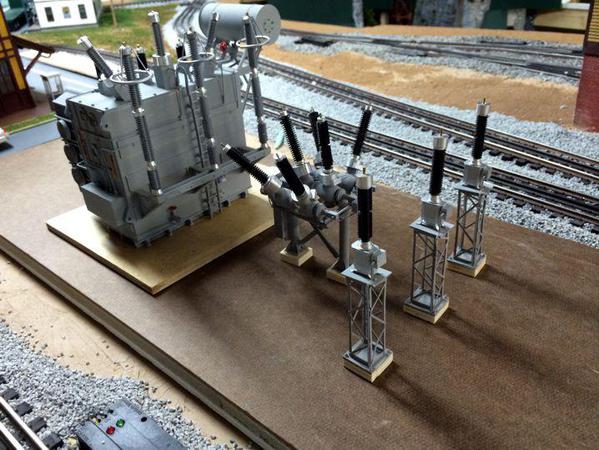
Now onto the Center-break Disconnects...
First up was building 6 leg sets. I decided to go with styrene here. It's just so much easier to join pieces than using brass. I measure the height of my CVTs against the disconnect drawing and found the ABB drawing was about a 1/4" shorter than the CVT. Again, I want these to be at the same height since I'm using rigid aluminum bus bars to connect the high voltage equipment. So I added this height to the legs.
I measured and cut the lathes in the lathe using a razor saw to make the cut and then very lightly facing the end to ensure that it's perfectly square. I then made a bunch of disks using the hollow punches. I used 5/16" for the top plate and 3/8" for the bottom plate. The bottom plate receives the angle brackets so it needs more width.
I eyeballed the glue job, and then to make sure that the disks were concentric and also square I again chucked the legs up in the lathe and made very light cuts on both the edges and faces. A little clean-up with a sanding stick finished them off.
I cut a bunch of little rectangles and then clipped off the corner to make angle brackets that looked like what ABB was using. These were then all glued onto the legs.
This is the last work you'll see until the 28 or 29th. The trickiest part of this job will be the various links that control the connecting arm's movement. I'm thinking of making the connecting beams out of brass, but that's not final.
Attachments
I'm trying to imagine what this will look like all together. ![]()
The leg braces look good. Just like all the rest!
I'm back! Trip back East was great, ending with seeing my granddaughter sing the National Anthem at a Penn State ice hockey game in their new 100 million dollar arena. It was the largest crowd so far that saw this amazing 9-yr old kid sing the heck out of the Star Spangled Banner. It made such an impression that the sports writer who was reporting on the game made special mention of the performance and suggested that the team should have her back since they won 7-1 over Holy Cross and she must have been a lucky charm.
The trip started with my wife and I going to the York Show. I didn't buy much, but got a nice Tomy 1:50 John Deere Excavator at the DHS booth as a load for my new flat car. I also got some Artista figures for the substation, some concrete colored paint and some Tichy NBW castings. I also spent some time with NJ International discussing getting operating crossing signals for the layout. I didn't buy then, but will get back to them to start the process.
Here's the excavator sitting on the car. I'm going to add some chocks and chains. The car also needs some weathering. The excavator is new and will not be weathered.
Here's the substation crew.
And I finally got back to work on the disconnectors.
I cut and installed the cross-pieces out of .100 X .125" styrene using solvent cement, and then cut a piece of fine-grain Masonite for a "concrete" base. To this I CA'd the 6 stands after laying out their location on the pad.
After putting them all on I realized that the pad needs to be twice as thick so I cut another piece and and laminated them together. When dry I sanded the edges so it looks like on thick piece. This matches the base heights of the rest of the equipment.
I plopped it on the substation base to see how it looked.
While it's a little tight, it fits.
Lastly, I started making the moving parts for the disconnecter. There are 6 long rods and several short ones. The long ones take the rotational energy of the center phase and sends it to the end phases to rotate those insulators. The short ones send the rotational energy to the opposite pole of each phase. Under each insulator will be a movable plate that will be brass with a soldered pivot pin. I didn't have a #56 drill so I drilled the plastic cross-bars with a #57. The brass for the pins didn't fit, so I took a piece, ground a flat on it, chucked it in a pin vise and used it as a "D" bit to enlarge the holes. The local big box home stores don't carry individual number drills, nor does the ACE hardware nearby, so I may have to buy them on-line. For numbers 60 through 80 my local hobby shop carries them individually, but not the lower numbers.
To make the operating rods, I flatten and shaped the ends with the vise-grip technique and then drilled a .032" hole for the smaller pivot pins.
Attachments
Trainman,
I'm glad you had a great trip! Sounds like you had a good time. We formed a TA group (Trainman Anonymous) to get through Trainman withdrawal. We survived.
The substation looks great! Also the excavator on the flatcar is a great addition!
Thank you for sharing!
Perhaps we could formalize the TA support group and I could collect dues...It would help support the habit.
I've been perusing DHS Diecast's website and some of the construction models are so cool it almost makes me want to switch hobbies from trains to construction equipment. They had a beautiful Manitowoc high reach crane at the show that he'd sell me for $400. I was very tempted. I do want to buy some form of crane model to use as a prop either next to the substation or to move around to any in-progress construction project on the railroad.
Thanks for reading... I'll keep writing.
Yes, I think you could get away with charging admission!!
I agree $400 is a little steep. You could buy a really nice locomotive for that price. You will find something suitable.
Keep writing, and we will keep reading!
You're correct! It would be another hobby to get involved with and I can't handle that right now. (Although I'm lobbying my better half to get a 3D printer.)
The boys had a day off today (Halloween?) so after peeling them off the little screens in which their heads were buried, I got them into the workshop. Grandson #1 was attaching details to his on-going F-22 Raptor project and #2 landscaped some more barren areas on the layout and filled in some ballast areas that were damaged during all the scenic building.
While this was going on I did some more work on the disconnecters which included machining the rotating plates that sit below the insulators and finishing up making the control rods.
I made six of these (actually 7 after one got away into the quantum rift). I drilled a hole into this big wood block I found to hold the pieces while I prick punched and drilled the operating holes around the perimeter.
I then assembled some of the pieces for the trial fit. I quickly found a slight anomaly with the spacing between the three stacks is slightly off. The C-t-C distance from the left to the middle is about an 1/8th inch shorter than the C-t-C distance from the center to the right stack. I shortened two of the rods so they are all aligned and will have to keep them separate when I finally assemble them.
If I want to make this piece actually operational—other than my grandson thinking this would be cool, I actually have no valid reason why I should go to the trouble—I think that I will have to make an addition to the scheme. I noticed on the plans that the attachment point of the control rods is further out from the center of rotation than simply attaching it to the disk. I will have to make an extension arm that brings out the pivot further. This is necessary since the rod binds when it only rotates about 1/8th. To fully separate the contact arms they should rotate 90º, not 45º. With the pivot holes so close to the center of the hub, the rods impinge on it and can't rotate. If I'm not making it actually perform, I can leave the pivots where they are.
I will have to machine another brass disk to sit at the bottom of this assembly. Here's my design for this detail.
I'll solder the control rod pivots to the hub and may add a spacer to the center pivot to keep the bottom plate at the right distance. This pivot assembly is the most complicated of the disconnector. Whether it's operable or not, it should still look good.
Attachments
Spent some time out of the shop working on CorelDraw to detail the disconnector mechanism. I'm going to cut some bell cranks out of brass that will lie below the insulator bases. If I fabricate it right, it should actually be operational.
I've come to a conclusion about what industry to feature on the railroad... a bourbon distillery and rick house. My daughter lives next door to the owners of a large distillery in town and we've become friends. I can get some good details on construction and should make a neat and interesting addition. I bought some grain cars at Roundhouse Trains yesterday to begin the process. N #2 grandson thinks it ought to be built right in the town. He said, "people would like to visit, so why not put it where they can get to it." I like his reasoning. I have lots of vacant space in town.
Attachments
Started building the operating mechanism for the disconnecter. After printing out the drawing and sticking it to some brass sheet with 3M77, I located all the holes and drilled them while the drawings were still attached to one big piece. I then cut them out using a jeweler's saw. This went pretty well.
After cleaning up all the edges with the belt sander, files and sanding sticks, they came out decently.
Here's where things started getting dicey, before completely screwing up.
To attaching the moving rods to the bell cranks, I chose to solder 0.032" brass rod to the plates with the small holes,
then using the small spacers that I produced on the lathe from some small diameter brass tubing, I trimmed the pins to the same .052" height. I assembled the pieces together and then attempted to solder the blank up plate. My idea was to have the upper plate capture the rod onto the pin so it wouldn't fall out. Everything went swimmingly until the very last piece. I was using the resistance soldering unit to apply the heat.
And here's what it all looked like when things starting hitting the fan. First, I couldn't get the solder to behave to attach the bottom plate to the shaft. When I picked up the unit to look at it, the bottom plate along with all the rods, fell apart. Then one of the eyes on the long bar broke from the center bell crank, finally it all came apart.
With this failure, I'm rethinking the engineering. First of all the brass is too thick. It scales out to almost 2 inches. I bought some .015" brass sheet today to remake the bell cranks. Next, soldering the pins on one side and attempting to put a blank plate on top to contain the rods wasn't good. The pins should go through both pieces. Lastly, the center large bell crank actually blocks 90º rotation. At best it gives 45º. To correct this problem I need to separate the right left rods from the fore and back rod and mounted on different planes.
So here's plan B. I'm going to solder two thicknesses of brass together, and drill and cut them at the same time to ensure that everything lines up. I will then Solder the tops and bottoms together with the spacer and center shaft, and then install the rods and pins. The pins won't need to be soldered at all. I'll just pinch the pin that extends out of each side to make it so it will no longer fit into the hole and then trim of any excess. This will allow me to do all soldering without any moving parts in the way.
If this doesn't work, plan C is to simulate the whole affair with styrene.
On another topic. I'm going on a private tour of the Heaven Hill distillery in southwest Louisville on Friday. I went on Google Earth to get some aerial pictures of this installation. It's not a very big plant and could work well with selective compression. Heaven Hill Bourbon has two installations. The distillery with some old aging houses in Louisville, and a very large barreling, aging and bottling facility in Bardstown, KY. The Bardstown bottling plant is 1,200 feet long by almost 800 feet deep. In O'scale, that's 25 feet long, by 16 feet wide, and that's just one building. So I'm staying away from that.

You can't see the storage silos in the above picture. There are 6 big ones that are about 25 feet in diameter. They could be shrunk in size and I wouldn't need 6. My trip on Friday will certainly help me in understanding what can be done in my scale and what should be left out.
This picture shows some old aging houses in Louisville. These are big. They're too big to do in scale and I'd only make one of them. They look like brick structures. In Bardstown, they're corrugated metal siding covering a very large timber structure. Building a "rick house" is an art in itself. They entirely constructed of very heavy oak timbers and the rack assembly is independent of the roof and side walls. They hold immense weight.
For example, a loaded bourbon barrel weighs almost 500 pounds. One rick house holds 42,000 of them. Heaven Hill has over 1,000,000 barrels in storage. 42,000 barrels weighs 21,000,000 pounds. There is plenty of air flow through the building since there is constant evaporation of alcohol vapors out of the barrel. There's no ignition sources allowed anywhere near these buildings. A 20 year-old barrel of bourbon in storage loses about half of its liquid.
Imagine trying to plan for a business where your product has to sit in inventory for 8 or more years before selling the first bottle. With bourbon undergoing an international boom (helping both Kentucky and Heaven Hill) they can't produce enough, but alcohol you distill today can't be sold for a decade or more. It's a tough business. The empty barrels cost about $42 a piece. Imagine 50 million dollars just tied up in the barrels. When they're used, they are sold to the scotch industry for aging.
I'm sure that's more information than you've asked for, but it's good for us railroaders to understand the industries on our pikes and what infrastructure they would need to thrive. Modeling any large industrial facility in O'scale is a challenge. Just ask the guys building petroleum refineries and steel mills. A bourbon distillery has lots of interest having some food industry and chemical industry aspects. They are served by railroads especially to bring in raw materials. Heaven Hill has their own tractor-trailer fleet for delivery.
Attachments
Oh man, so much. that is a good idea, using the images of actual buildings and all as a a start for ideas and such. And you mechanisms are just fantastic. Wow.
My mechanisms could be better... especially if they worked. I tend to over-engineer. Speaking of over-engineering... we all praise German engineering, but they too over-engineer. While living in Germany, our house had these very sophisticated large windows. If you turn the handle 1/4 turn, the window would open inward from the top. but if you turned it a half-turn, the window would open fully from the side. In addition to this, the window had all sorts of cams and latches that would lock it closed. Very engineered. It took burglars 15 seconds to break into such a window. Just because something is highly engineered and complicated doesn't make it better. It's all about function. I hope my second design is better.
I redesigned the bell crank mechanism for the front unit(s). This is made of much thinner material and will require some bending, but no spacers and should be easier to solder in one go.
The rods are staggered so they won't interfere with one another. I won't be able to get to this till next week. Tomorrow I have a retina checkup resulting from getting flashing last year, and Friday is the trip to the distillery. I may have time Friday afternoon when I get back.
I visited the maker's room at my grandson's school today. I'm offering my time as a mentor. They have a 40W Full Spectrum Laser engraver/cutter and a Makerbot 3D PLA plastic printer. It's the rebirth of Industrial Arts Education which has almost died in the USA. I graduated as an Industrial Arts Teacher from Michigan State University in 1968. At that time, we had an entire wing of the Education building with all the shops represented. In 1985, when I had the opportunity to visit again, those rooms were already vacant and the program no longer existed. In other words, the US was losing the desire to teach kids to make things already. This was long before the cry about the US losing manufacturing jobs. The canary was in the coal mine and it already was dead.
Finally, some folks are beginning to realize that not everything can be done in a virtual world. At some time folks actually have to make something. I am very excited about being able to help in this effort. As a side benefit, I'll be able to do some model work with those amazing machines.
Attachments
Wow, with this much effort, I think you could engineer real ones!
Oh no! You wouldn't want me designing HV equipment.
I fabricated the redesigned bell crank today. It came out as planned, but unfortunately my plan wasn't exactly right. I still can't get the range of motion I need on the rods. I'm going to stop working on this aspect, make it a fixed detail and get on with the rest of the disconnector. I've got a lot of stuff to do and build and can't get too bogged down on a detail that really won't ever be necessary.
I also had that plant tour of the Heaven Hill Bourbon Distillery in West Louisville. It was an excellent tour and I took looks of pictures. This project will be so comprehensive that it deserves it own thread, so I will now start that thread to run concurrently with this one on the substation.
I made the new bell crank out of three formed pieces of .015" brass stock. I bent the offsets, then drilled the .047" center hole so I could put a rod in them to align and hold them. I used the RSU and TIX solder and got a solid job. I then drilled the .032" holes through both sides of the clevis and got nicely aligned holes.
After cleaning them up a bit, I attempted to assemble the rods in the clevises along with the brass pin. I had to reshape the rod ends a bit and clean out the clevis from some excess solder and got the pins to go through everything. The problem with range of motion lies in the clevis blocking the rod from rotating inwards. This greatly limits the amount of travel and makes the opening and closing of the contact arms an impossibility. I suppose I could go back to the "drawing board" and do another go around, but frankly, it's totally unnecessary.
Here's all the pieces assembled.
I started preparing the insulators that will go on top of the rotation mechanism. I'm using a different Hillman auto body fastener for this one. It will take 3 insulators per connector arm. I have to cut one in half to make one segment, then there will be a turned piece and another 1-1/2 plastic part to make the other segment and then the top fitting with the disconnector arms. I'm going to make the arms out of square brass tubing so I can solder the various fittings and arc extinguishing pieces.
I have to buy more of this style to finish the job. I don't foresee any more complexities, but then I can be wrong. I know I have been very wrong in the past.
Attachments
Behind our entertainment center was a horrendous rat's nest of cables which my wife hated to look at. In our old house, it was in a location that you really couldn't look behind. In the new house, it was there to be seen every time we went out of the house or into our bedroom. We bought a ton of organizing stuff at the Container Store in Cincinnati, and I got to work on it. Needless to say it was difficult work, we had plenty of very "passionate" discussions and I finally did it. It took three iterations and over five hours of work.
Before:
After:
So, you may ask, "Why am I telling you all this?" Here's why. One of the most cogent arguments my wife was making when I made a first—and unsuccessful—attempt was "How come you work on stuff with your trains over and over until you get it perfect, and yet on this you're trying to pass off a sub-par job?!" (those weren't the exact words, but you get the idea. Bob might redact the actual words). It was a good argument, which I didn't like very much and it hit home. So I did it over two more times until the final result. Well folks. She's right. I do keep doing stuff over and over until it meets a high standard. And that's what happened in yesterday's session.
I was unhappy with version 2.0 of the bell crank mechanism since it was still blocking full rotation and therefore precluding any mechanical fidelity to the real disconnector. So I went at ver. 3.0.
What was really needed was a pin system that didn't protrude to the underside which kept limiting movement. I machined some small (really small) brass pins that would captivate the rods. While machining the pins, I also machined all the other bits that would make up the insulator stacks.
The pin diameter is 0.031"; the head size is nominal and doesn't matter very much.
I attempted to solder the pin in place holding the rod without soldering the whole deal together. This work...sort of...in one instance, but ended up soldering the rod to the pin in the other two. I ended up riveting the pin on the other two. It still needs some more work.
I was able to use the bell crank plate from Ver 1.0. Along side you can see the remains of Ver 2.0. The expanded pins on the two auxiliary arms are sticking down into the path of the long rods and is blocking their motion. I'm going to try and fix this a bit.
Here's the range of motion with the new design.
Once again the picture was flipped. I didn't take the pic upside down.
You can see if you look closely that it's getting something less than the desired 90º rotation. If I can flatten the protruding pins that might work. Now... the real way to make this correctly, IMHO, is to make some shoulder screws that are threaded into the bell crank plate. With a little Loctite on the thread, and filing the protruding threads on the bottom, the unit would work exactly like the prototype, which from the pictures seems to have ball-end connectors a la RC air craft servo connections. To this end, I've just ordered a set of jeweler's taps and dies that will enable me to make such miniature specialty screws. My wife was right, I don't give up until I get it like I want it.
After working on the mechanism, I spent some time building the insulator stacks. They consist of 1-1/2 Hillman auto fasteners in each section, with the aluminum turnings in each. This style of insulator doesn't have ejection pin blemishes or the missing segment like the bigger ones I used on the Xfrm, breaker of CCVTs, but I do have to cut them to make them work.
The insulators look very good with almost the right profile for the water shedders. Here's one stuck on the rotater mechanism.
I'll finish these today and get working on the actual disconnector electrodes. This is getting near done.
Attachments
Spy camera...
After messing around with the bell crank one of the holes broke out. It wasn't centered in the piece of brass. Since I had to remake the whole deal it gave me a chance to attach the pins by riveting them, instead of crushing them in pliers. I also found that the main crank was impinging on the cross beam.
Every time I crop a picture, this website turns it upside down. Doh!
I made a new bellcrank, and machined some more pins. One of the other mechanisms let go and I remade that one also. I ran out of the small brass rod and had to make lots of chips when carving down a big piece to 0.030" pin. I used my new Tap Matic brass cutting fluid to make the cuts nice and smooth. I used the cut off blade to do this by just plunge cutting in a series of bites until getting down to the finished size.
I again reassembled the whole affair and got pretty good range of motion. If I were to refine this further—and I'm not—I'd redo all the rest of the cranks and make them with the riveted pins.
Here's the new bell crank. If anything, it's certainly prettier.
This took a lot longer than I wanted. I lost at least two pins into the Quantum Rift. Seriously, I swept the floor twice and they were gone. So it was back to the lathe to make more. I got pretty good at making them. When I get my watch maker's taps and dies I'm going to experiment actually making my own miniature screws.
I did get the rest of the insulators made.
The last bit that needs to be done is the contact arms themselves. There are these aluminum plates that lie one over the other that serve to manage the arc on separation. I was planning on making the bars out of brass so I could solder thin brass supports to hold the aluminum arc management plates. Then I'm left with CA'ing the plates to the brass. I could make the plates out of brass and solder them too, but I would like to have the natural aluminum showing. It, like the bell cranks, will probably take multiple tries to get it right.
Attachments
Today started work on the disconnector arms themselves and the arc horns that attach to them. I also decided that another bell crank assembly needed to go the pins/rivet method which I'll do next session.
The arms are made of 1/8" sq. brass tubing, with the .047 holes drilled in them for the pivot shaft. The piece was measured from the distance between the poles and the pivot holes were picked up from the hole spacing in the base.
I cut them in half on a 45º angle with a razor saw and miter box, and then soldered a large copper plug into them on both sides that would act as the contact. That clearly was overkill.
The arc horns on these units are aluminum discs that are about 1 scale foot in diameter. I measured them on the plans at about .030" thick. I turned a stick of aluminum on the lathe and then parted off 14 of them at the right thickness. I use the digital caliper's depth gauge end that sticks out the other end of the bar as a precise gauge to set the longitudinal feed on the lathe. Someday, I outfit the lathe with some direct reading dials or digital readouts. There's stuff on YouTube showing how people did this. After parting about halfway through, I took a Swiss needle file and slightly rounded both edges and then finished parting them off. A file was need to remove the little nub that remains on the cut side.
These will be CA'd to the arms. One side has them mounted on a some brackets that space them away from the arm, and the other has them mounted directly on the arm so they pass under and over each other when the arms are connected.
To make the brackets I used some left over fret material from photo-etched parts. It's very thin brass that;s not too soft. It makes great stock for small sheet-metal details. Don't through it away! To solder them on I first tinned the arms with a tiny piece of solder on a fluxed portion of the arm near the middle.
A couple seconds with the RSU and the solder melted. A nice thing about the resistance unit is that it's always ready for use. It's only hot when you hit the foot pedal, and it's instantaneous. I only use the Weller soldering station for electronics work these days.
I formed the brackets, added a little TIX liquid flux and used the tweezers on the RSU to hold the bracket onto the tinned area on one side. A few seconds on the pedal and the pieces were fused.
I then held the bracket for the other side, used the RSU tweezers to hold both brackets to the arm (the previously soldered one and the new one) and again, in a couple of seconds the new bracket was on and the previous one was still there.
I then CA'd the completed arms to the insulator stack.
Upside down again. I was going to paint the arms before fixing them to the insulators, but decided against it since I wanted to CA to bare metal. I'll mask the insulators. I will be putting the arc horns on last since I want them to be natural aluminum. The arms would be more securely attached if they were soldered. Unfortunately, since the insulators are plastic, the soldering heat would wreck them. If i was to do this again—and I'm not—I would have soldered the arms on first, then assembled the stack. Live and learn.
As it stands now, the disconnect mechanism could actually work. I have no earthly reason for doing this other than it's just cool. I may be able to pose the station energized or de-energized. It was more just a self-challenge to see if I could do it. To make it just a static model, the whole deal could have been polystyrene like the transformer.
Attachments
Wow. You know, if you get tired of making this stuff, you could probably make Comet Landers and Mars rovers and get paid for it. Incredible
Lee... you are too kind. It's kind of funny... when I was laid off in 1986 (training folks get laid off about every 6—8 years depending on the business cycle—I was given out placement. In that process we were given occupational aptitude tests. Mine showed that I should be a model maker in the movie industry. Clearly, I'm just doing was I was destined to do, except I'm not getting paid for it.
Today, I rebuilt the last pieces of the operating mechanism that needed to be replaced using the rivet method that seems to be working pretty well. It's still not optimal. I started preparing everything for final assembly, and began building the little control box that would (in the real world) provide the impetus to open and close the contacts.
In order to keep the contact points aligned and set up the spacing as they wait to be epoxied in place, I made splints using tooth picks and iron wire. This is holding them in their final position so the epoxy can glue them in proper registration.
Since the mechanism is now as complete as I'm going to make it, I epoxied the bottom supports in place along with some spacers on the newly re-engineered ones since they are only one layer of brass instead of two like the original design was.
Here's all of that curing with the three sets of contacts waiting their turn.
Not ever seeing the machine operate, I didn't know how the contactors separate. Did they open in opposite directions or in the same direction as a double door would. To make it go opposite, the bell cranks are set up like the above. To make them open together, the rods would cross over the other side. After playing around with it, I decided that you'd get faster and wider separation by having them open opposite to each other.
I started building the little control box and installed a tubular cross-member between the center posts. The little box is just a smaller version of the one used for the breakers.
I got some new tools today. I found an Internet jewelry supply where I could get larger quantities of specific jeweler-sized drills. I bought 3 sizes that correspond to those of the three sizes of brass wire that I always use. I also sprung for a jeweler's tap and die set for really small screws from 2 mm down to .7 mm. This is for future projects that are going to have moving parts where I really want to do it right. I need to find information of what size holes and rod diameters are needed to cut these very small threads. As I said before, the ideal way to have made that contact mechanism would be to machine miniature shoulder screws that would be threaded into the bell crank.
I am sure I will break those small ones the first time I try to use them. I find that using Tap Magic really makes cutting the small stuff much easier. It was a snap to make those 0.031" pins.
Attachments
Lee may be one of a kind, but I think he is right! Excellent craftsmanship!!
I know the SVP of the power equipment company at ABB and sent him a link to this thread. I think it is fantastic work. I suggested maybe they look at them for an article in the employee magazines. I have no idea if anything will come of it.
It is often a mistake to turn a hobby into a job (actually, is is seldom anything but a mistake to do so) but I am certain that, well-marketed, you could sell these for some very pretty pennies, Trainman 2001. They are just fantastic. But if it were me, I wouldn't, just make them.
Yes, a hobby can quickly turn into a job. I was given this piece of wisdom from my dad when I was in my 20s. Dad, now 84, is an avid fly fisherman and fly tier. His flies still are impeccable. He can fake out all but the oldest wiliest trout. Back years ago, I asked him why he doesn't sell flies to Orvis. He has always had to pinch pennies, and Mum is a master at it. His still are as good as the ones they sell. He told me then there would be quotas and deadlines and it would no longer be a hobby to relax from a hard days work.
Mark, I think your father is right. I built models on commission back in the late 70s and 80s. It probably works out at pennies per hour salary. When I built the B-17 several years ago, I made the deal for $600 with the owner providing all materials. It ended up taking 13 months and I think I made $0.60 an hour... not enough to do anything except maybe buy modeling supplies.
It's always a temptation to build for fee, thinking that it would feed the habit, but often it ends up in not working on the projects which got you into the business in the first place. I just advised a young colleague who was thinking about making custom, high-quality furniture as his vocation, that making a piece that sells for $5,000 must be repeated 20 times in a year to provide a living wage after expenses. I suggested, he do like Mark's father, build furniture for his own enjoyment, and if he sells something at one time or the other, take your family out to dinner to celebrate. Otherwise, you have to get on the Art/Craft show circuit and that's not fun.
Trainman,
Yes, this is a lesson our artist daughter who is still living with us is learning. Every art teacher or professor she has ever had said she has tremendous talent. How were we to do anything but encourage her to make the most of God's gift to her in college studies. She has run into just the situations you have mentioned, and is frustrated with her low sales. To make matters worse, we don't have the space she needs for a full art studio, and she can't afford it herself. Coupled with some physical problems and a stubborn personality, we all live in frustration. Her boyfriend of 7 years graduated with a degree in graphic arts and is working at a local convenience store, not finding work in art so far either. It took a long time for his sister, also an artist, to be able to make her art profitable, but she had to wait until her son was in high school, and her husband advanced to the point he could carry all the family bills. I don't know how to apply Pap Pap's wisdom to their situation, but it is a learning process every young adult faces in some form or another.
Back to the P&PRR power substation construction!! ![]()
I'll digress just a little bit longer...
My nephew is 45 years old. He's a very creative and terrific artist. His work is installation art. Large structures you interact with that use lighting and music which he creates himself. He's been waiting for "His big break" for 20 years. Each deal is the one that's going to do it. It hasn't. Meanwhile, my brother in law, who is a successful pediatrician, and is 80 years old, keeps supporting him and is fed up. He claims he can't retire because of the son's dream. I'm sure there's some truth to that, but I also don't think he wants to retire regardless. Meanwhile, my nephew is living out my sister's dream. She wanted to go into the arts, but it was the late 1950s and my parents had other ideas. It's a tough life, and like going into professional athletics, a few make it really big and the rest don't. Just thank G_d that we live in a country and age where our loved ones can chase their muse without having to work in the fields, or get drafted. I've counseled my nephew many times hoping to get him to go into a professional that can pay him a living and then work the art at the fringes, but he insists that he has to devote all his energies to it. That's life. Good luck to you and your daughter. Now I'm going into the workshop.
Epoxied the contact arms and insulators to the rotating mechanism, and then went back to building the control box. The mechanism works...sort of. As this movie shows, the arms do move in synchronicity. But... the angle cuts I made to the contactors are now wrong. They were put that way when I was planning on having the arms move off in the same direction to the right. When I changed the scheme so they would move apart in opposite direction, the angles were now backwards. The arms can't engage properly. The arms are glued to the insulators with CA and can be broken loose with some friendly persuasion. I turn them over and the angles will be in the right orientation.
Here's the assembled unit.

This shot shows the backwards angles.
The control box is now done except for the door handle. After I took this picture, I glued on some styrene angle that will support it when attached to the cross member. Also not shown is the vertical shaft, the new operating lever, and the outer brass tubing jacket. I'm in the process of machining as brass bushing to support the operating shaft more securely than just sitting in a hole on top of the control cabinet. One or two more work sessions should finish this up. I'm going to seal the wood base prior to painting it "concrete", and masking the insulators so I can air brush the rest, Tamiya Sky Gray. I may use a coat of Krylon primer first since it holds onto metal better than the Tamiya acrylic.
Attachments
without words!!
AG
Thanks AG! I attempted, vainly, to remove an arm to be able to turn it around so the angles can let the arms open and close. It didn't budge and I wasn't going to wreck anything. I could grind the angles off to let the arms clear each other, or just fasten them together and leave it as a static model. I really won't be able to operate those arms once it's on the layout anyway.
I finished the control box by machining a little bushing that's inserted into the box top and allows the operating shaft to turn and be properly aligned. This worked so well that I made bushings for four other locations where the bell cranks attach to the frame.
The cross arm is just .108" wide and the pin is 0.047", so there wasn't much plastic to work with when I enlarge the holes. I made the bushings 0.070" with a 0.052" hole.
The box was solvent glued to the cross piece and the operating shaft dropped in. I had to bend the bell crank link so it would align properly with the shaft's crank end. I machined another pin. Since there was a slight elevation difference that needed to be matched, I also machined a small spacer with a 0.047" hole. The excess pin that was hanging out was squeezed with the needle nose to deform the end so it wouldn't pull out.
The last bit of detail was some Tichy NBWs to "fasten" the posts to the "concrete".
I don't have any sanding sealer, so I sealed the Masonite base with some Testor's Dullcoat lacquer to it wouldn't absorb the acrylic paint that I'm going to use to simulate the concrete color. And the last step was masking the insulator stacks in preparation for painting which I'll do tomorrow.
I couldn't help myself... I stuck the unit onto the substation base to see how it looks.
Attachments
Incredible work.
it will be move by a servo or manual?
Andre.
Amazing.
Very cool project, & photo story.
Trainman,
It reminds me of my days at Virginia Power! The most realistic power substation equipment I have ever seen by far!! Thank you so much for taking us through the process! You are certainly a craftsman extraordinaire!! It is so realistic, when you had the substation worker posed by the cabinet, I could feel the shock from the time 25 years ago when I got nailed with 220VAC as I related at the time. This is certainly lower voltage equipment but I remember static was so high in the 500KV stations, that if you didn't wear a glove opening the cabinet door the static would eat you up! I could hear the static crackling as soon as I got out of the van to open the gate.
What are you going to use for buswork and for a fence and gate?
Thanks guys! I'm using thin aluminum tubing for bus bars, plus small black iron wire for any flexible leads. For fencing I'm leaning towards Brennan's chain link fence. In fact I'm fix'n to order it today. I've been thinking about building my own fencing, but I don't want anything sub-scale that will detract from the work within the fencing.
Well... if you liked that take a look at this. I put it all together today, air brushed the gray, added the ABB logo, and painted the concrete base. While I was handling it, this happened.
It was the result of I think two causes. I think the cross member was a tad wide... I mean 5 to 10 thousandths wide, and was putting pressure on the pole base. Then I was using a paint that uses acetone as the solvent. The vapors may have penetrated the base to pole joint and I was holding onto this center support while painting and "Crack", the base broke loose and then the cross member. Luckily, styrene is forgiving. Before rebuilding, I sanded a bit more of the curvature to make the piece a bit shorter and then reglued and repainted the whole deal. I overcoated the concrete paint with some craft acrylic that I mixed using black, antique white, and some yellow ocher. It's not a bad mix.
And then I took these.
As you can see, I CA'd the arc extinguisher disks to the arms. The little brass brackets worked perfectly. CAing metal to metal is always a challenge. Sometimes it seems like it's fully adhered and then you touch it and it fall apart. I find when that happens it's best to scrape off all the hardened CA and start all over. Otherwise, you get buildup and the piece has even less surface contact area upon which to adhere.
Again, I plopped the disconnector onto the substation base and took some shots.
With the disconnector complete, the HV equipment section is complete. Next up is the gantry assemblies that will bring HV into the station. And then it will onto the low voltage secondary section. In many installations, the transmission voltage, (10 to 12.5 KV) is then run into cables and run under ground. I don't know if this was done in the 50s. I highly doubt it, but neither did the transformers, breakers or disconnects look like this in the 50s, so I'm already mixing eras. I'm going to use small aluminum bars for the bus system.
As a reminder, here's the drawing from ABB's literature. This unit shows all the options available some of which I chose to leave off. Those smaller horizontal rods flanking the cross members are "earthing bars" that swing down to ground the assembly when the circuit opens. It's an option on the real one and I chose not "buy it".
On another side-bar... I use a Logitech Track Ball Mouse that has this big, red plastic ball that you roll around with your fingers instead of the thumb. It regularly falls off the arm of my easy chair and the ball pops out and rolls all over the place. I've had two others before. Sometimes, the impact of hitting the floor forces the little spherical pad into the bar and puts a ding it in. This ding then gets caught on the pads periodically and jams it momentarily. Well, tonight I decided to attempt to fix it. I found the ding, sanded it down so there were no raised edges and then filled it with a tiny drop of thin CA. When cured, I sanded it flush using a 400, 600 and 800 sanding stick and then polishing compound. The ball is now smooth and is fixed. Taa Daa!
Attachments
Super! Nice operating disconnects. Yes the bus sounds good. Long ago I thought the era was a bit off for your layout, but who cares, this is O gauge, and this is fantasti!
Yup! That's right! It's O'scale and I can set whatever era I want and even mix them. If any of you watch "Gotham" on Fox, you see anachronisms all over the place. It's supposed to be the 60s, based on the cars they're driving, but there are computers all over the place. It's like that.
Besides, 1950s era substations had black painted equipment and all the gantries were fine lattice that is very difficult to model, or expensive to buy if you go the Plastruct route. I may use some more lattice on the low voltage just to mix it up a bit. There's a modest-sized control room that will be built by traditional methods unless I can get some stuff laser-cut. I wish the prices on those were dropping as quickly as they are on 3D printers. It's that CO2 laser tube that adds to the cost.
As I look at the pics more, I'm thinking that I'm still not getting the concrete color right. It should be a bit lighter and have more tan in it. It now looks like fresh wet cement. I'll keep working on it before I paint all the other concrete parts. If anyone has a mixture formula I'd be happy to hear about it.
Well, I just got the word from the project manager that work has commenced on the civil work in the substation. I'm using 1/4" H-beams by evergreen. These would be a scale foot wide... maybe a bit big, but they'll work and it's the size I used on the plot plan.
My angle cutting came out a little too shallow on the first piece I did and I used that as a template for the remainder. I suspect that since these towers aren't going to support any switchgear, that the narrower leg stance won't be a problem. I scored the angle with a single-edged razor and broke the piece off at the score line. I sanded the cut line so it was truly flat and then used solvent cement to glue the legs together. When this set up, I measured and cut a single reinforcement piece. For the angles, I reset the fence on the Precision Sander and put the angle on both pieces. It's the same way I did the truss angles for the bridges project.
I then reset the fence again so I could sand the bases of the H beams so they would properly sit on the base plates that will be glued on next. I also sanded the top joint flat and level.
I've found some problems with the Touch-n-flow glue applicator. The plastic and the solvent cement seem to have opposite static polarities. Sometimes the drop at the end of the capillary tube simply jumps off the applicator and hits the plastic WHERE I DON'T WANT IT. Add to that my unsteady hands (hadn't had lunch let an blood sugar was down) and there's glue where I don't want it. I sanded off the high stuff, but I'll use a touch of Sovereign Green model putty to level it all out before painting.
Oh, I also cleaned up the work area before starting this next phase. I got word today from O'Scale Mag that there is the intent to publish the next phase construction article. I'm hoping to do a long-running series on the entire substation build.
Attachments
I am glad the project manager was finally able to get all the right of ways, environmental impact studies, and additional permits approved! Sometimes that takes so long in to get approval in both the electric power and telecommunications industries.
i have had similar problems with some CA. It seems to go everywhere.
For me, this is one of the best projects ever described on these forums. I look forward to it each day. Wow! This is fun!
I'm very happy to please. It's a lot of fun for me to. And if I can keep publishing the articles about it, the project could actually turn a profit. Life is Good! Now that the really hard parts are behind me, it should be easy sailing... "Other than that Mrs. Lincoln, how did you like the play?" "Pride goeth before the fall." Bending the bus bars so they work as they should could be more trouble than I anticipate.
For me, this is one of the best projects ever described on these forums. I look forward to it each day. Wow! This is fun!
Well, it's certainly going to be one of the most detailed modeling jobs I've seen, it's amazing how much work it takes to make something like this! Your RR will certainly have sufficient power once the sub-station is completed. ![]()
Thanks Gunner! My big industry is the planned Bourbon operation... They consume a lot of steam, but don't have too much in the way of very high HP motors. Now if I was building a low density polyethylene plant, now that's a different story. In the early 80s, I was the training coordinator for ARCO Chemical. They had a plant in Port Arthur, TX that had a very large shed filled with hyper-compressors (50,000 psi) and each was powered by a 5,000 hp synchronous motor. Now that was a power load! They also had one powered by a uni-flow reciprocating steam engine built by Ingersoll Rand. I loved being around that stuff.
Port Arthur. Wow. I haven't thought about that place is ages. they did have some big industrial facilities and private plant-only substations there. I did some power system work over in Port Arthur although it was 1977 or so, so we didn't overlap there, Trainman2001. But almost.
Lee, it was interesting that they used crushed clam shells as ground cover throughout the plant. I also developed and taught a course on locomotive safety there. They had two Alcos (RS2 & RS3) which they abused to the point of failure. They didn't just make polyethylene beads. They also made PVC, and for this they needed chlorine. They received it in tanks cards. They would run the engines without the train brakes hooked up. Tried to start too many loads with the small switcher leading to burned tires and deep gouges in the rails. One time the slippage was so great that they slammed the throttle shut from notch 8. The resulting back EMF blew the generator apart. So I was asked to run a course. During the research I found out that certified operators were letting warehouse men run the engines on night shift so they could have fun "running the trains". All of these practices were stopped. They handled enough chlorine to be a big hazard for the entire region.
Only had an hour in the shop today so not much got done. Did a little more finishing of the gantries, cut and attached the base plate, and glued up the stock that would be the "concrete" pads. I measured and cut the top cross-members, but will wait until the mounting pads are installed so they'll be more stable standing up.

From this sandwich, I'll cut off the four concrete bases. This is German High Density Fiber Board. It's very hard and very smooth textured. I used it for the fascia boards and bought it while still living there. It's a higher quality than the Masonite I've found here in the USA. All of the German lumber was very high quality. Would you expect anything less?
Tomorrow I'll add these bases. I have a minor loco repair I'm also going to do. HV gantries should be done next week.
Attachments
You're such a craftsman. Though I don't comment everyday on your work, I do check this thread daily.
Beautiful describes your work.
Lee, it was interesting that they used crushed clam shells as ground cover throughout the plant. . . . . They had two Alcos (RS2 & RS3) which they abused to the point of failure.
The crushed shells as ground cover was just pragmatic. You could literally get them by the ton for nothing along the coast. They were okay in that roll as long as you did not try to go barefoot . . .
It wasn't just locomotives that big industries abused. A lot of the industrial plants along the gulf coast I worked with loaded equipment up to levels and neglected equipment beyond anything a utility company would dream. Whereas a utility will load a transformer like the one you modeled up to a peak level that will give it an expected 65-75 years of service lifetime, I've seen industrial plants burn them up in only seven and a half years, just overloading them 24/7 and running them very hot. They also do very little maintenance - as one plant manager told me "Why do maintenance? Everything on it will last at least ten years in you don't, except the core, and we'll burn that out in about eight and just scrap it . . . "
Posted by 86TA355SR:
You're such a craftsman. Though I don't comment everyday on your work, I do check this thread daily.
Roger that comment. I also read this everyday. Excellent work.....
Lee, it was interesting that they used crushed clam shells as ground cover throughout the plant. . . . . They had two Alcos (RS2 & RS3) which they abused to the point of failure.
The crushed shells as ground cover was just pragmatic. You could literally get them by the ton for nothing along the coast. They were okay in that roll as long as you did not try to go barefoot . . .
It wasn't just locomotives that big industries abused. A lot of the industrial plants along the gulf coast I worked with loaded equipment up to levels and neglected equipment beyond anything a utility company would dream. Whereas a utility will load a transformer like the one you modeled up to a peak level that will give it an expected 65-75 years of service lifetime, I've seen industrial plants burn them up in only seven and a half years, just overloading them 24/7 and running them very hot. They also do very little maintenance - as one plant manager told me "Why do maintenance? Everything on it will last at least ten years in you don't, except the core, and we'll burn that out in about eight and just scrap it . . . "
Sounds like the change in philosophy of the power company I worked for. Originally we maintained everything as best we could and updated a lot. Then in 1995, they wanted to become 'the low cost producer'. That is when they changed to the 'run it until it smokes' philosophy. That is also when they permanently laid a bunch of us off. Many other power companies did the same, and I ended up back in telecommunications where I started out in 1976.
Sounds like the change in philosophy of the power company I worked for. Originally we maintained everything as best we could and updated a lot. Then in 1995, they wanted to become 'the low cost producer'. That is when they changed to the 'run it until it smokes' philosophy. That is also when they permanently laid a bunch of us off. Many other power companies did the same, and I ended up back in telecommunications where I started out in 1976.
Its never fun to be on the downward side of downsizing, but it was an industry-wide trend that hasn't stopped yet.
What I find most interesting is that while traditional utility folks think industrial plant managers who treat equipment like this are "so stupid," plant managers look at how utilities load and service equipment, shake their heads and say, "They're wasting so much money." The traditional reason utilities didn't load equipment to the point it would run hot, and "took care" of it was they didn't want the service outages that would occur when it failed. But increasingly smart systems mean that doesn't happen anyway. It actually makes sense to buy a small transformer and just use if up at high loading levels in only a decade or so, and then just replace it. I call this a "buy burn and bash," philosophy and wrote about it in one of my books: from the right perspective even a half-million dollar transformer should be looked at as a disposable component to be used up in the process of running your business.
Good discussion!
I did a little substation work, getting the G hv gantries finish sanded. I also cut and final shaped the concrete pads.

I was going to epoxy them today, but instead got to work on another small project. I'm planning on selling my Lionel late-model F3s (the hi-scale ones produced in the mid-2000s), but one of the B units had a missing swing hanger that broke off way back when I was first unpacking the engines when they were new. I was sure that I could make a new one and install without problems. Funny how you think that sometimes and it couldn't be further from the truth.
Here's a good truck showing the parts.
What I didn't know until I got into this was that these parts are all die-cast. This greatly complicated drilling holes to receive the new parts.
I fabricated the new swing arm out of 0.030" brass. I figured I'd try this first and then go to styrene if that didn't work. I drew the parts on Coreldraw and made cutting templates. I used the jeweler's saw with the fine blade to cut the brass and then finished it with a diamond wheel mounted in the Dremel flexi-shaft. I shaped the ends so they would fit into small holes drilled in the brackets that were remaining attached to the truck's side frames. I had to prick punch the bracket and that's when I found out that it was cast metal, not plastic. When I tapped the punch with the hammer (lightly mind you), the bracket broke away from the truck, and, to make matters worse, the swing arm axle fracture into two pieces.
The truck now looked like this.
Since I had the bracket, I was able to drill it when off the train by holding it in a pair of forceps. I was going to put the axle back together with some reinforcing wire which meant I needed to drill a 0.024" hole down the center. The piece was 0.050" in diameter so I figured I had enough wall thickness to handle it. I didn't. When the hole got 30 thou into the hole, the whole piece fell apart. Now I had to fabricate a new axle too. Like I said this was supposed to be simple.
Here's the bit and pieces.
And here's the start of the new swing axle.
I'll solder those little plates to the 0.047" rod and then cut to length. All this stuff will be J-B Welded to the truck frame. I'll prime paint all the metal parts and paint them flat aluminum after assembling. If worse comes to worse I'll have to buy a new truck frame if they're available. It's not the first time a little job turns into a not-so-little job.
While I really like these Blombergs... they're beautiful and among the best renditions on anything out there. And I also appreciate that they're all die-cast parts, but they are much harder to repair, they're brittle, and make life miserable when they don't work the way you want.
The only reason I'm selling this beautiful A-B-B-A lash up is magna-traction. I wrote about this at length months ago, but I can give the executive summary. Magna-traction attracts the slightly magnetic roofing granules I'm using as ballast and gets into the drive gears stalling the engines and overheating their electronics. I can't use them on my railroad.
Attachments
It is amazing, Trainman, how many parts are diecast on model trains. It makes the lot of the modeler/basher difficult, but the manufacturers have it down to an art!
Great work as always.
I think it's the Chinese that have it down to an art. They must have a vast die-cast industry since not only are train models using it, but all those construction models that are made there. Add to that the 1/42 and 1/18th car models and you have a lot of precision die-cast capability. But it sure is a bear to work with when it breaks.
Went with my wife, daughter and the two grandsons to see "Interstellar" this afternoon so had less than an hour in the shop. In this hour I epoxied the concrete bases to the gantries,
I then used the same epoxy to glue the bracket back onto the truck from which it detached.
I also used the RSU to solder the little rectangular pieces onto the swing axle shaft. It takes longer to type this than to fire up the RSU and solder the pieces. I measured the spacing with calipers.
I filed the ends to the correct length. I then fitted the swing hanger to the truck and it looks good. Unfortunately, just the pressure I put on the bracket to insert the hanger into the bracket that HADN"T broken, broke it loose too. I'll epoxy that tomorrow. I prime painted the axle and swing arm. I'll probably work in the shop on Black Friday, since we're not going anywhere that day.
Even without the aluminum paint it looks pretty good. The swing hanger is not glued in this picture. I'll glue it in when I fix that loose bracket on the left.
I was going to glue the second detached bracket tomorrow, but decided to do it tonight so it would be cured tomorrow and not delay finishing the job. I glued it on and added weight on top of it so it would bond in the right attitude.
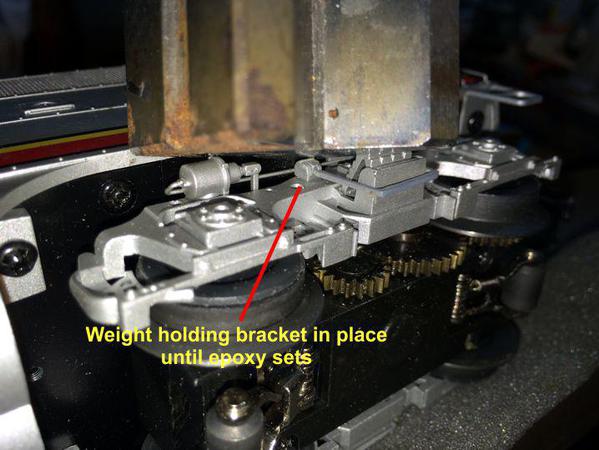
As for Interstellar... it was interesting, well acted, scientifically dubious, had an annoying sound track, and has a music volume that was so high that all of us, including the young ones, actually had to put our fingers in our ears. It was almost painful. I have a decibel meter loaded on my iPhone, but was reticent to take it out in the movie and turn it on. I would bet it was at least 105 db and probably higher. It detracted from a pretty good movie. I'd like to watch it at home on my system so i could adjust the volume to less harmful levels.
Attachments
As for Interstellar... it was interesting, well acted, scientifically dubious, had an annoying sound track, and has a music volume that was so high that all of us, including the young ones, actually had to put our fingers in our ears. It was almost painful. I have a decibel meter loaded on my iPhone, but was reticent to take it out in the movie and turn it on. I would bet it was at least 105 db and probably higher. It detracted from a pretty good movie. I'd like to watch it at home on my system so i could adjust the volume to less harmful levels.
I know what you mean. My wife refuses to go to the cinema anymore because of the booming surround sound. (I just remove my hearing aids and have mo problems at all!)
Anyway, we don't go to the cinema anymore - we wait and stream the movies on Amazon or one of the other services here at home. Its a shame, I love to go to the movies, but the cinemas seem to think they have to give you something you can't get at home - like 200 decibels of teeth-rattling sound!
#2 grandson, commented last Saturday, when we were watching "Guardians of the Galaxy" on my big entertainment system the we don't have to go to the movies any more. In fact he said "that I don't go to movies any more!", completely forgetting that he, his mom, my wife and I went to the movies 2 weeks ago when we saw "Big Hero 6". His dad and #1 were in Chicago going to a Northwestern-Michigan game. The also got to the Museum of Science and Industry and he brought me back pictures of their vast HO layout.
Lot of topics to cover in today's report...
Finished the repair on the Santa Fe and it pretty much meets my expectations, but I'll leave that up to you guys. The new swing hanger is a little bit thicker than the original, but you have to pay attention to it to see it.
I made the 6 hanging insulators for the gantries, and then finished gantry assembly. I added NBW castings to the base plates, and applied Aero Gloss sanding sealer on all apparatus bases in preparation for concrete painting. Meanwhile, #1 grandson was working with me. First he was going to get into decaling the F-22 only to find that each and every decal was cracking and disintegrating. I tried to use the "Put fixative on the decals" method to prevent them from cracking, only to have them change color and become basically useless. These are the low-viz markings that are used on USAF stealth 6th Generation fighters. I now have to find new decals for the model. So... making lemonade, he went back to work putting down more ground cover on the layout. He then pulled another model off the shelf—a 1:350 Trumpeter Model of the USS Hornet including little models of B-25s that Doolittle used in the Tokyo Raid. He'll have fun with that one.
Here's the insulators. I turned little transition pieces to dress them up a bit.
I then installed the cross members that connect the two gantry towers. These are butt-jointed to the towers and I added some little gussets to reinforce the joints. The cross members are 7.5" wide and clear the Disonnector by about 1/8" on each side.
Sanded the base plates to coincide with the "concrete" pads exactly. Then used the sanding sealer to seal the wood to improve finish for the acrylic "concrete" top coat.
Measured and drilled the holes for the insulators in the bottom cross members. For the gantry over the disconnector used their spacing for the holes, but for the one that will sit over the breaker, used the spacing of the surge suppressors on the main transformer. Finally, I added True Details NBW castings. These are available in the hobby shop as are used for auto model detailing, but they're a nice size for larger 1:48 simulated fasteners. They're resin castings and can't be glued with solvent cement. You need to use CA.
I ran out of time so didn't get a coat of paint on them, but I did set them down on the substation base to see how it looks. With these built, the HV section's apparatus is now complete. After painting, I'll add back the insulators.
This landscaping is either temporary, not quite finished or both, but we're are making progress covering the bare layout. The first is a retaining wall next to the station's access road. #2 grandson and I built it several weeks ago. #1 grandson painted it last weekend and I installed it with Titebond glue. Today I added back the ballast. It needs weeds, debris and other detritus that accumulates at the base of such a wall on an active railway. You can just see the substation base on the left.
Here's some grass down #1 applied to the long back run. I said temporary because I don't know the ultimate use for that territory, but it needed some dressing up.
And finally, we're starting to do ground cover in the area around the switch tower. The idea is that there will be an unimproved road from the engine service area, across the five yard tracks and then leading to the switch tower with a small parking area. It needs more material, but that will wait until next time.
Whew! That covers today's work. I'm getting itchy to build the land forms around the substation base. This has to be done soon since I'm going to have to start fastening the apparatus to the base and finish the ground cover on that (fine gravel), and I don't want to be manhandling that very complex structure when attempting to do plastering and ground cover. I'm just not relishing getting back into the plaster business.
Attachments
I think the only one who could tell the Santa Fe hanger is thicker than the original is the builder. Very convincing.
The insulators and the gantries look great.
The landscaping is looking good too. Your landscape professionals are doing quite a good job!
Thanks Mark. I'm going to put the Santa Fes up for sale now that they're complete.
I think my landscapers have their green card, but it's more like a "don't ask, don't tell scenario" since they're all obviously underage. They get paid in hugs, kisses, and lots of presents.
The gantries are finished. I almost forgot to put the lightening rods on them. I made them with a piece of 1/16" brass tubing with a piece of 032"wire soldered into it. I sharpened the rod to a point so lighting charges on my layout will be dissipated before they cause a strike. I then CA'd the to the corners of the H beams. With that it was ready for airbrushing. I proceeded to knock them on the floor and broke a base off on leg. After putting back on and a little touch-up paint it was good to go. The insulators are held with CA.
I realized at this point that I was going to have to get sloppy with some Scuptamold. Before I can start installing any high voltage bus wiring, I'm going to have to prepare the base to permanently mount the equipment. I can't do this until the site is prepared. So I removed all the stuff that was being displayed, took the base and covered it front and back with Stretch and Seal, and then started plastering it into place. I also built a little topo using layered cardboard stapled to the OSB. This went much faster than using cut Masonite like was done on the other side of the train station.
Here's the plaster work started on the board and showing the cardboard elevation pieces.
Shortly after this was taken, it was all plastered. I'm definitely getting better at this...
I wanted to pull the base board before the plaster fully hardened. This is the first time I used this method which was brought to me by Ashe Rawls from Richmond, VA. He admonished me to never permanently glue buildings into the layout since you may have to remove them for service, or if you want to sell them. He wraps the base with Saran Wrap and plasters right up to the edge. Then he is able to make a socket for the building. He used light landscaping to hide the seam so you never know that the buildings aren't permanently planted. I especially wanted to do this for the substation.
To pull it I screwed and eyebolt into the Masonite top surface and gave it a tug. It came out but the strip of plaster on the near side did break loose from the platform. It went back to position and if it's loose I glue it in place with either hot glue or white glue. Shouldn't be a problem.
It takes several days for Scultpamold to fully cure. The plaster sets in 30 minutes, but the fiber filler takes a long time to fully dry out and I don't want to paint or landscape until it does. Meanwhile, I'm now starting on getting the base fully detailed.
I mixed some "concrete" acrylic and hand painted the bases of all the finished equipment. Tomorrow is going to be poor weather again. Goody! More shop time without a guilty conscience.
BTW: I did order Brennan's Chain Link Fencing. I'm asking Dennis about how to add barbed wire extensions to the fence top since many electrical installations have it to keep silly people out. If there are any ideas out there on how to do this, I'm listening. I'm figuring a couple more months work on this project. I have others waiting in the wings... lots of them.
Attachments
. . . I have others waiting in the wings... lots of them.
Oh goody! I hope you post pictures of them, too!
I'm thinking about the barbed wire. Interesting challenge.
If you are buying fence rather than scratchbuilding, several suppliers sell barbed-wire. There are some links in this thread:
https://ogrforum.ogaugerr.com/topic/barb-wire-fence
If you prefer to scratchbuild, here is one way to make barbed wire:
Some people simply wrap thin wire around a nail to form barbed wire coils. The barbs aren't there, but they are pretty tiny in O-scale.
I looked at the barbed wire videos. It certainly seems easy enough to do, although tedious and somewhat dangerous since you're actually making metal barbs. Dennis Brennan also suggested using plastic screening cut down the lines leaving little barbs. He says they can be attached to the fence tops with shipbuilding eyebolts. i have some of those. I'm not sure I'm going to add them, but at least I know there are options.
Plaster was drying well and will be fully cured in a day or so. I worked more on the base plate, laying out where everything will go and then cut the concrete pad for the control room.
Using a Sharpie, I laid out the center lines of all the equipment.

Based on the design, the foundation for the control room intersects with the transformer's concrete pad. Again, I'm making a sandwich of two layers of Masonite. I ran out of enough of that wonderful German stuff so there's a layer of old, not-so-hot, pressed board glued to one piece of the German hardboard.

I then started working on the intermediate voltage gantries. I didn't have styrene small enough in cross section to do what I wanted, but I did have brass. So using brass channel of two different sizes I started construction. I really want to get all the apparatus on the secondary side completed too before I attach anything to the base and do the gravel ground cover.
Here's a SketchUp drawing of the gantry.
Insulators will be hung from additional brass pieces soldered to the shorter cross members.
I used the razor saw and miter box to cut the pieces to their three lengths. I use a block clamped to the work bench as a bench stop to cut multiple pieces. I also cut four square 0.032" brass plates that will be soldered to the bottoms of each leg. I'm finding that using the TapMatic brass cutting fluid works like a charm on all the hand operations I'm doing. This includes using the razor saw, drilling with small jeweler's drills and using the jeweler's saw. It just makes the cuts smooth without any binding or grabbing.
This is another great chance to use the resistance soldering unit. I'm starting using a higher melting point soldering to solder the longitudinal cross-members. I'm soldering on the ceramic soldering pad. It handles high heat and also is easy to hold things with "T" pins.
I set the heat range to 80%. The brass has a lot of mass so it took a few seconds to heat high enough to melt the silver bearing, non-lead, plumber's solder. I'm using the old square to hold things at 90º.
For the inside corners I'm using V-blocks. I also am using the TIX liquid flux. It works for all of the solders that I have. I cut a small piece of solder, place it next to the joint with a pair of tweezers, and then clamp on the RSU. As soon as the solder flows into the joint I release the foot switch and hold the RSU in place.
Even with my precautions, I was unhappily surprised that one of the two sets was not in square. So I reheated and separated the offending pieces and will re-solder it tomorrow.
The one on top is the good one.
Tomorrow, I'll be assembling them into a square structure. The TIX solder melts almost 100º lower than the solder I used for this step so it shouldn't de-solder the previous joints. At least that's the theory.
I don't know what's going on with the picture handling engine on this site. Almost every picture I posted was turned in a way that was not on the original image. I shot them all with my iPhone, all were shot landscape and all with the phone in the same orientation. I didn't crop any in my Corel PhotoPaint, just fixed contrast and re-sized, but yet the pictures are turned. I know I've carped about this before, but today it was particularly annoying. Am I the only one that has this problem?
Attachments
I'm wearing out the word "Wow!." But, Wow!
With regard to the barbed wire. Why make the barbs? At 1:48 they will be about 1/100 of an inch long, and about 2.5/1000th inch wide. You would have to have your eye within a few inches to see them. I'd leave them off. Safer and more comfortable to work with. You still need really fine wire.
I agree with Lee, "Wow". Your craftsmanship is just amazing.
Trainman - I took a second look at your posting and saw your comments about the image handling on the forum turning them around, etc. It can be frustrating but there are small inconsistencies in software from cameras, phones, and systems that creates these and other problems (I had one with contrast for a while). I solved nearly all of these by a "trick" that takes a bit but ultimately saves time. Regardless of which of three cameras or phone I take the photo from, I copy and paste the pictures into MS Powerpoint, arrange them covering each page like I want, and then "save as" the presentation as a JPEG file(s). Powerpoint creates a folder with a jpeg of every image (only the part covering the slide, cutting it off at the edges). It also compacst the files (from perhaps 6 Mb to 100 kB! so they now load onto the forum so much faster) and whatever else it does, I never have problems with them now. It's a pain to do but I do it most of the time and my inversion and contrast problems have all ended.
Lee, thanks for the tip! I'm loathe to go through another step in this process since I'm already bringing the images into Corel PhotoPaint to adjust color and resample to a lower bit count. I've actually spoofed the system by rotating the pics in Windows file viewer, and then rotating them back. For some reason this resets the image to its original format.
I had only minutes in the shop yesterday so I re-soldered the non-square cross member. Today, I'm going to finish them up. I also found the medium voltage breaker to use. It's ABB, nice and compact, and rectangular (since it's easier to produce in styrene).
As usual, I was able to pull a full set of prints for it.
I also need to find a medium voltage, outdoor disconnector which would complete the apparatus for the entire station.
Attachments
Wow. It is a nice unit, although I am prejudiced. I was actually in charge of that product line for a while about umpty years ago!
Compared to the size of the HV stuff, the medium voltage equipment is puny. I finished soldering together the MV gantry. It went together nicely again as the direct result of the RSU's capability. Here's the fixturing I used to ensure that it came out reasonably plumb and square.
The small Irwin quick clamps are very handy and I use them all the time. It's also important to have supply of square edged things. I have two V-blocks, 2 small angle plates and one larger one, and I could use more.
To mount the insulators I soldered some 1/8 square brass tube into the channel. Before soldering it in place, I laid out and drilled holes for the insulators. One set is spaced to match that of the secondary output bushings on the main transformer, and the other set reflects the spacing on MV breaker I'm going to model.

MV disconnects are almost exactly the same as the fused disconnects I made for the telephone poles (now) many months ago. They are also small and inconspicuous compared to the large switch I had to build for the HV side. To hold these switches in the gantry I soldered two more cross members. I coped the ends of these channels so they nested into the side rails.
I also soldered some 0.032" brass rod into the insulator holes. Since I'm dealing with brass into brass, I decided to solder these rods. In the rest of the construction I usually CA'd them in. Soldering is much more secure, but I couldn't do this AFTER the plastic sheds were added to the brass rod since it would melt. So here's the completed gantry.
In staring at this picture I realized that I soldered the switch support bars on the wrong side of the gantry. In this image, the gantry is turned around. The insulator pins with the wide spacing goes next the transformer pad and the side with the narrowly spaced insulator pins goes on the left side. The support bars should be on the gantry's transformer side. I will de-soldered and move them tomorrow. I suppose the switches could reside above the breaker... hmmmm.
This was actually the first fully-brass construction I ever made. The brass shapes were bought years ago in anticipation of making something from brass. It all had to wait until I bought the RSU and had the right project. I'm now feeling my oats and will probably try to build my own signal towers. The RSU will also be very helpful building the Brennan chain link fence. i got a great deal of satisfaction building this.
Attachments
Still watching, this is a fascinating project, can't wait to see the finished project. I wouldn't be surprised to see electricity flowing out of the substation! ![]()
Glad you're still following. I'd be very surprised if electricity came flowing out of this project. I will have to provide electricity to it since I'm going to build some light poles with LEDs. It would cool lit up at night.
The gantry looks great! I do agree now that you mention it the proper placement of the support bars should be moved. Actually, I probably wouldn't even notice. ![]()
I can send my daughter's hamster with running wheel down to Kentucky, so you can hook it up for generation. I have joked before the since some of those critters run all night, they could generate a nice amount of electricity.
The gantry was fixed so the cross bars are now on the correct end. I also made the concrete pads for the gantry and the circuit breaker. The CB is also completely out of brass. But you can't see it. Reason? My HP dv6 laptop blew up today. I'm writing this on my wife's iPad Mini and don't have any pics loaded.
The laptop is about four years old and was on almost continuously for that time. a couple of weeks ago the fan started making noise. It kept getting louder. My son had a similar HP and his flan died also. He said it sounded like an old window air conditioner. Very apt description. Then software starting running weird, especially CPU and video intensive ones like SketchUp. Tools would freeze or the mouse would stop working. I did research yesterday to see about cleaning the fan. A pain in the butt! You have to disembowel the entire computer to get to it. And you need special thermal transfer paste specific to HP (according to Intel) For the heat pipe connection to the main chips.
Then today when I came up from the shop, my computer had stopped with a bios message saying the fan had ceased operation and continuing to use would cause severe damage. I'm now in the market for a new machine. My wife, bLess her heart, thinks I should finally make the switch to Mac. In fact she thinks I should get a MacBook Pro like my son has. One must always do what one's spouse wants. My daughter in law is a Mac maven and suggests getting a refurbished one. They're 400 dollars cheaper. I'll keep you all posted on what's going on.
Meanwhile, the brass circuit breaker box came out pretty good. I'll try uploading the pics to the cloud and getting them to this a Mini and put them on another post.
I figured out how to load the pics
Attachments
My son-in-law and other daughter's boyfriend are big Mac users. I like the iPad I have, and may get a Mac when our PC dies.
Mark, see previous post for. Pics.
Once again, very convincing! Thanks!!
Well fans, it didn't take long before i was up and running with a new laptop. I sprung for a big one, the MacBook Pro with the 512GB solid state main drive, and Intel i7 250 ghz cpu it's a quad core monster that does SketchUp like butter. In fact, in just a small test I realized how awful the other machine was getting. It was struggling mightily in running SketchUp.
I didn't work in the shop today, but I did get some stuff done yesterday. I had added the concrete pads the day before and they were fully cured, I added some more details to the breaker and then rattle-can sprayed them Krylon primer gray. Tomorrow I'll airbrush the lighter gray and add the insulators. These will then be done leaving just one more detail; the mechanical disconnects that will go up into the gantry. In looking at the base, I'm beginning to think that instead of a brick control building which is overkill, I'm going to leave the concrete bare as a place to bring in service vehicles through the gate that will be at that corner.
I added the small rear door and turned and soldered the bushing transition pieces. The RSU really made this assembly possible. My challenge in working with sheet brass is not having the sophisticated sheet metal tools like shears and brakes. When you cut this stuff with tin snips, it tends to curl up and then it gets kind of beat up when flattening it again. I would have like to have made the body with just one piece folded, instead I had to solder individual plates to small interior angle pieces.
Here's one view in primer
And the other. I used some filler on the seams before the final coat. The lever on the left side is the manual trip lever which I'm going to paint bright red.
The fencing came from Brennan and that will be up after I make the disconnects. Onward and upward.
Now all i have to do is retrieve the myriad of files from the hard drive i removed from my old computer. The drive was okay and my daughter in law sent me an enclosure to turn it into a auxiliary drive. But... I can't find my data on it. i can find all the program files, windows files etc, but nothing that looks like the several thousand files that represent all the work that I've done. If anyone out there knows how Windows encodes the User data files, please let me know.
Apple said I may have to load Windows and run it using the Boot Camp utility. But there's a rub. You have to obtain a native Windows 7 or 8 ISO file, and then obtain the Windows install utility that was used when they loaded it in the HP originally. Needless to say, both of these requirements are messing with my head.
But the computer is very cool!
Attachments
Fantastic unit Trainman2001. I love to study how you make things. Very interesting.
And it looks really nice.
Interesting about the paint. For about fifteen years from 1994 until 2010, I didpart time duties as Series Editor of the Power Engineering series of books for Francis and Taylor (CRC). It didn't pay much but it forced me to read copious numbers of power engineering books which kept me up to date, and I got free copies of all CRC technical books . . . Anyway, they came to me and asked what colors I recommended to give a common look to the covers of all the books in power engineering. I gave them the panatone colors used to paint electrical equipment, the sky gray and dark green. So my eight books, plus many, many others in power engineering published during that period were all were done up in the colors you, and the manufacturers, are using for your equipment.
Attachments
Pretty interesting info Lee.
It is amazing the difference in speed when one gets a new computer. Sounds like you got a good one. I too find it very strange that you can see the program and operating system files. Did you put them in My Documents folder? Maybe a hidden setting is selected. Why, I wouldn't know.
On to the breaker. It looks very good once again. As far as not being exactly smooth, it gives the impression of a workhorse that has seen some bumps while being moved, and a few sloppy coats of paints over the years. Yes, those things sure can happen when the substation guys get hold of some equipment. ![]()
I've uploaded 35,000 pictures and then spent the rest of the time culling them down to a mere 16,000. Some years ago, my son in law had asked me to back up his pics on my computer. Those pics have been reproduced in each new box I've owned. I've now removed them. There were also many duplicated rolls. I've kept all the important ones.
A good example of the performance different between this machine and my last. When I was rendering the Bernheim distillery image from SketchUp it took 35 minutes on the old one. It took 5 SECONDS ON THE NEW ONE. That's correct... 5 seconds. Almost instantaneous. Programs load in a blink. All I can say is magnetic hard drives are dead, long live magnetic hard drives. Moving the files from one computer to the other was an ordeal, but it was worth it. It was the main reason why I didn't want to change regardless of how badly the other one was running. But the breakdown forced my hand and I'm not complaining.
Back to the topic...
I'm making the MV disconnects. Like some of the other components are like jewelry making. I'm using little channels for the bases and bending (and drilling) the thin stock from PE frets. They're almost "operational", but that really doesn't matter. It's all about appearances.
Here's the little brackets soldered to the base channel.
This was my second attempt. The sloppy solder job was due to the middle bracket de-soldering when I was putting in the last one. I was using TIX solder with melts under 300 degrees. Once TIX joints come loose, it seems very hard to re-solder them and things get messy. I started using a very fine diameter electronics solder for the remaining units.
I drilled the first center bracket when it was off the base, but found this to be very awkward and difficult to center all three holes.
All the rest I soldered first then drilled.
For the moving contact, there is a bar attached to one of the ends that lifted and moved away from the fixed contact by motion of the middle swinging insulator. I had to drill a 0.032" hole in the center of a 0.048" square brass rod. Like I said, Jewelry Making. By carefully getting the punch mark dead-center in the brass enables the drill to drill the hole and still leave some wall thickness at the edges.
The bracket to which it's attached also has three holes; one clear through for the pivot and then one in the middle where I soldered the mounting pin. Jewelry making!
Here's the unit assembled. (one of three...one for each phase)
And lastly, here's the disconnect just sitting on the gantry's cross bar. I was going to try to screw them on and attempted to make some #10 Jeweler's screws. I machined some blanks that were .033" in diameter, cut the threads with the Jeweler's die plate i recently bought, and then used a small drill for the tap drill size and cut threads with the #10mm tap. It worked...sort of. But they stripped very easily. I tried twice and then decided to epoxy the disconnectors to the gantry.
Since taking this pic I also built one more with one to go. Once they're built I'll hand paint the base leaving the brass bare. I'll also air brush the gantry and MV breaker sky gray and with that, all the apparatus will be built and it will be onto the chain link fence kit. I still have to build lights and a small control enclosure. Like I noted before, I'm not going to construct a large control building since I want to leave some parking space inside the fence.
Attachments
Wow, that is tiny detail.
Wow, that is tiny detail.
Yeah. You are quite insane, you know. ![]()
![]()
![]()
Seriously, my hat is off to you!
If you do the rest of the layout in this detail, it's a lifetime project!
How much smaller are those compared to #00 #000 screws?




